�
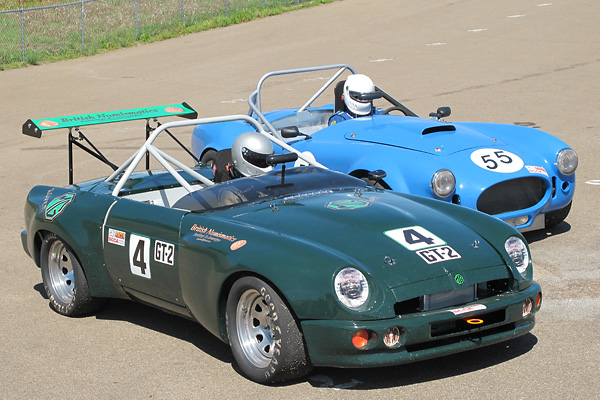
�
Built For SCCA's GT2 Class: Phil Leonard's MG RV8 Racecar
� � Owner: Phillip Leonard� City: Kansas City, Kansas
� Model: MG RV8 (circa 1992/3)
� Engine: Rover 3.5L aluminum V8, built by Bill Davidson
� Built by: Clancy Schmidt, Robert Maupins and Scott Mock
�
�
Rover Group's MG RV8 Model
��
The MG RV8 was a low volume, luxury sportscar introduced in 1992. Two thousand were built in a production�
run that spanned two years. The RV8 was only ever intended to be a limited production model. Rover�
Group sought to bring the MG trademark back before the car buying public and to do so in the best possible�
light before returning in force with their upcoming, more modern, and far less expensive MGF model.�
�
The British automotive press generally wrote very favorably about the RV8. As hoped, articles focused�
on the historic reputation of the MG brand, a badge long synonymous with "sportscar" for so many�
enthusiasts. Magazine writers especially emphasized the phenomenal and enduring popularity of Abingdon's MGB�
model. At that time MGB was still the best selling sports car model in automotive history. The RV8�
delivered what many MGB owners had wished for; much more power and a more comfortable driving experience�
topped the list of virtues, but it remained a true open sportscar.�
�
The MG RV8 was only ever produced in righthand drive configuration, and with very few exceptions sales�
were limited to the British home market and to Japan. It was okay for Rover if sales were extremely�
limited, so long as interest was piqued. They only wanted to inspire aspiration. Readers would close their�
magazines thinking: "I wish Rover would introduce an MG sportscar in my price range." or even "I wish�
Rover would start selling MGs here again." The RV8 was a teaser. The MGF was coming.�
�
Please support the sponsoring companies who make www.BritishRaceCar.com possible, including:
� �
 �
�
�
�
�
Code-named "Project Adder," the RV8 development team worked with a shoestring budget and a tight schedule.�
They could do so because from the beginning their brief was to utilize the original MGB bodyshell as�
a foundation. British Motor Heritage had previously collected and restored original MGB press tooling and�
assembly fixtures and was already building "Heritage" bodyshells for MGB restorers. Heritage shells are�
actually better than original MGB shells in many respects. For example, corrosion protection is superior�
due to use of galvanized zinc-coated steel sheet and also due to electrically deposited "e-coat" primer�
dipping of the assembled bodyshells prior to painting. The new RV8 body was styled by laying clay over a�
Heritage MGB bodyshell and then sculpting away until the RV8 shape emerged. A muscular bulge in the hood�
and a substantially wider stance resulted.�
�
What about the drivetrain? That was a no-brainer. Many technical details had already been worked�
out in advance. MG itself had already produced ~2600 Rover powered, factory-built MGB GT V8 cars�
in the mid-seventies. Both before and after that, swapping Rover V8 engines into MG's was popular�
with enthusiasts. Many hundreds if not thousands had successfully completed the swap. Rover electronic�
fuel injection and Rover five speed transmissions had been installed already. The whole drivetrain was�
in current production for other Rover models. Technical success in the drivetrain area was a foregone �
conclusion.�
�
All production MG RV8s were powered by a 3950cc (94mm bore, 71mm stroke) version of the familiar�
aluminum V8. Static compression ratio was modest at 9.32:1. Lucas multi-point fuel injection provided�
the engine with refinement. Only one new fuel injection part needed to be developed: a plenum cover with�
an MG badge on it. Early production RV8s used Rover's LT77 5-speed, but an improved variant of that box�
came along as a running change. For casual drivers, the principal difference with the R380 5-speed is�
that Reverse moved from left-side to right in the shift pattern. Changes from original MGB specs include�
15" aluminum wheels, telescopic shock absorbers all around, 270mm vented front brake rotors, a limited�
slip differential, and tapered monoleaf rear springs with torque rods to refine axle location. Arguably,�
the most interesting new idea introduced to engine swappers was that exhaust headers should exit through the�
wings instead of hugging the engine block. (Bonus: adding holes in the inner fenders aided cooling.)�
Advertised power: 187hp at 4750rpm. Advertised torque: 235lb-ft at 3200rpm. 0-62mph in 5.9 seconds.�
Max speed: 135mph.�
�
Please support the sponsoring companies who make www.BritishRaceCar.com possible, including:
� �
 �
�
�
�
�
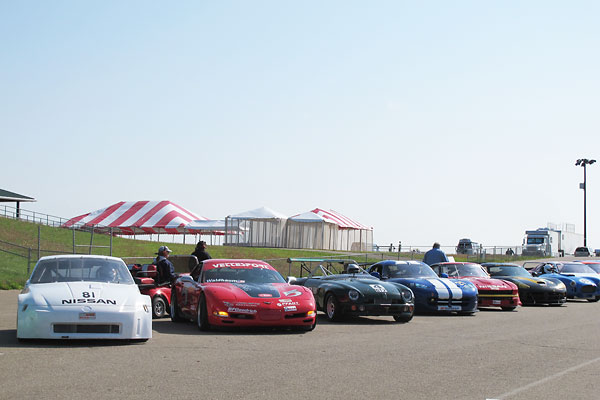
�
Finally: the door is open for MGs to race with the big boys in SCCA's Grand Touring classes!
�
The Building of Phil Leonard's RV8
��
Phil Leonard has been racing an MGB GT at the regional Sports Car Club of America (SCCA)�
level for several years. As time progressed, getting in and out of the GT became a bit inconvenient,�
especially with its full roll cage. Phil started thinking he might prefer to race an MGB roadster.�
Another consideration was that typically MGB roadsters race with low profile windscreens. Between�
reduced frontal area and reduced weight, MGB roadsters are generally more competitive than�
MGB GTs in SCCA racing.�
�
Phil recruited a couple good friends to help with his MGB project, including notably Clancy�
Schmidt and Robert Maupins. They found a suitable MGB to start with, and began stripping�
it down. The team's original idea was to build their MGB to a "Full Prep" standard and race it�
SCCA's "F-Production" class. (A less extensively modified "Limited Prep" MGB woulld�
instead qualify to race in SCCA's H-Production class.) A full roll cage was built and welded into�
the MGB's unibody bodyshell. Coilover front and rear racing suspensions were installed. �
�
Then the "what if" thoughts started popping up. "What if we could install a bigger motor?"�
"The MG RV8 was basically just a re-styled MGB with a Rover aluminum V8 engine installed�
from the factory, so why don't we build an RV8 replica?" These sort of thoughts might have been�
easily dismissed if Phil and his buddies weren't building up the new racecar a stone's throw from�
SCCA national headquarters. Did I forget to mention that Clancy actually works for the SCCA?�
The idea of petitioning SCCA to make a home for MG's low volume RV8 model didn't seem�
far fetched at all. �
�
In SCCA's "GT" classes, most competitors have severely cut away or even completely eliminated�
any "unibody" type structure. In other words, body panels are no longer load-bearing; most external�
body panels are simply "skins" mounted on quick release fasteners. Instead, most GT class racecars�
are built from the ground up around custom fabricated tubular structures. These structures efficiently�
provide great strength and stiffness for minimal weight. �
�
Phil's RV8 is only partly consistent with this paradigm. Most of the car's exterior bodywork is�
composed of lightweight replicas of original steel panels. Under the skin though, most of the�
original sheetmetal unibody is intact. The rationale here is that SCCA's minimum weight for the�
RV8 was set high enough that a full tubular chassis wasn't necessary. Phil's RV8 runs right at the�
minimum allowed weight. On the other hand, if Phil's RV8 had been built with a full tube frame�
it probably could have been built several hundred pounds lighter and then brought up to the�
SCCA mandated mininum weight requirement with ballast positioned quite low. With a tubular�
chassis, suspension mounting points could be optimized far more easily.�
�
Where did Phil get his RV8 body and trim parts? Most of Phil's original MG RV8 body panels�
came from salvage yards in England. Some other parts came from Ron Davies, a retired Rover�
factory Competitions Director who had spares left over after administering an RV8-only spec�
racing series.¹ Finally, after hurricanes hit the Caribbean and destroyed a couple MG RV8�
sports cars, Phil was able to purchase some of their parts. From this mix and match assortment�
of original parts, the team created molds, and now they can create duplicate fiberglass parts as required.�
The bumpers, bonnet, boot lid, and fenders seen in our photos are all fiberglass replica parts.�
�
�
IMPORTANT ANNOUNCEMENT
�
BritishRaceCar.com will have to cut back plans for continued growth if we can't find more financial support.
�
If you like what you've found here, and you want to see more, please click here and follow the instructions.
�
Readers like you keep BritishRaceCar.com online and growing through voluntary financial contributions.
�
Features and Specifications
�| Engine: | �Rover 3.5L aluminum V8 engine, rebuilt by Bill Davidson.�
10.3:1 static compression ratio.�
D&D Fabrications rocker shaft assemblies with reinforcing towers at their ends.�
D&D Fabrications modified / rebuilt harmonic balancer.�
Edelbrock Performer 3.5l intake manifold.�
Holley 600cfm four barrel carburetor, model 0-4224.�
Edelbrock air cleaner.�
Delco-Remy (GM/Buick) distributor with Pertronix Ignitor breakerless module. �
Taylor Pro Wire silicone 8mm spark plug wires.�
Custom deep sump oil pan.�
Flotec low profile oil pump base.�
Earl's 16-row oil cooler (part# 81610).�
Fram HP3 oil filter, on a Moroso remote mount.�
Accusump oil accumulator. | �
| Cooling: | �custom aluminum crossflow radiator by Saldana Racing Products.�
Custom remotely mounted aluminum header tank by Saldana Racing Products. | �
| Exhaust: | �D&D Fabrications RV8-style (through the fender) four into one headers,�
with high-temp powder-coat finish.�
X-pipe. | �
| Transmission: | �Borg Warner NWC T5 5-speed, currently with 0.63:1 fifth gear.�
D&D Fabrications bellhousing.�
McLeod hydraulic throw-out bearing. �
Hurst shifter.�
Wilwood master cylinder. | �
| Rear End: | �(as shown in photos below, but used only in the car's very first race) � early MGB banjo-style axle, in stock width but used with hub spacers.� 3.909:1 ring and pinion.� Open differential, but with gears welded solid. | �
| Rear End: | �(as configured for its second race on, from August 2011) � Speedway Engineering "Mini Stock" floater-type custom housing (Ford 8").� Full floating hubs.� Rifle-drilled driveshafts.� Curry aluminum gear carrier.� 3.8:1 ring and pinion.� Ford limited slip differential. | �
| Front Susp.: | �Fab-tek front suspension, highly modified by Clancy Schmidt.�
Carrera coilover shock absorbers.�
Fab-tek anti-sway bar on aluminum pillow blocks. | �
| Rear Susp.: | �three bar linkage plus Panhard bar.�
Koni coilover shock absorbers. | �
| Brakes: | �(master) Wilwood pedal assembly, featuring dual master cylinders and adjustable bias bar. Ford brake fluid. � (front) stock MGB (Lockheed) calipers and rotors (solid). Hawk "blue" brake pads. � (rear) Wilwood calipers and solid rotors. | �
| Wheels/Tires: | �Spin Werkes 15x7 aluminum racing wheels (~11#/ea. Nearly zero offset.)�
Goodyear Eagle 23.0x9.0x15, R430 compound racing slicks. | �
| Electrical: | �lightweight gear reduction starter from BritishStarters.com. | �
| Instruments: | �(left to right)�
AutoMeter shift light (red), �
AutoMeter Sport-Comp fuel pressure (0-15psi),�
AutoMeter Sport-Comp water temperature (120-240F),�
AutoMeter Autogage programable tachometer (0-8000rpm),�
AutoMeter Sport-Comp oil temperature (140-280F),�
AutoMeter Sport-Comp (engine) oil pressure (0-100psi), and�
AutoMeter Sport-Comp (oil accumulator) oil pressure (0-100psi) gage.�
An AutoMeter Autogage oil pressure gage (0-100psi) is mounted in the engine compartment. | �
| Fuel System: | �ATL Sportsman 22-gallon steel canister fuel cell (part# SP122B).�
Holley red electric fuel pump.�
Earl's inline fuel filter. | �
| Safety Eqmt: | �Fire Bottle centralized fire suppression system, with three nozzles.�
Kirkey aluminum racing seat.�
RJS Racing Equipment five point latch and link safety harness.�
Sweet Manufacturing steering wheel, mounted on a Sweet Manufacturing quick release hub.�
S.P.A. mirrors (both rear view and side view).�
Cole-Hersee battery disconnect switch (model 2484). | �
| Misc.: | �Cosmo Racing "Aluminum GT Wing" single deck / single wing spoiler, 130cm (part# W63FSS). | �
| Weight: | �2202 pounds, including driver and fluids.² | �
| Racing Class: | �SCCA GT2! | �
Engine Installation
��
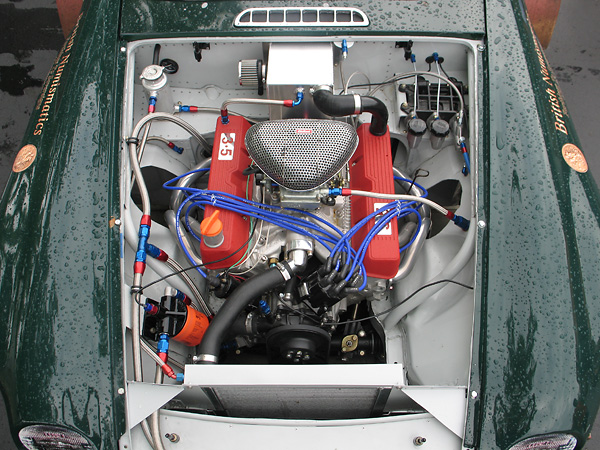
�
Rover 3.5L aluminum V8 engine, rebuilt by Bill Davidson.
�
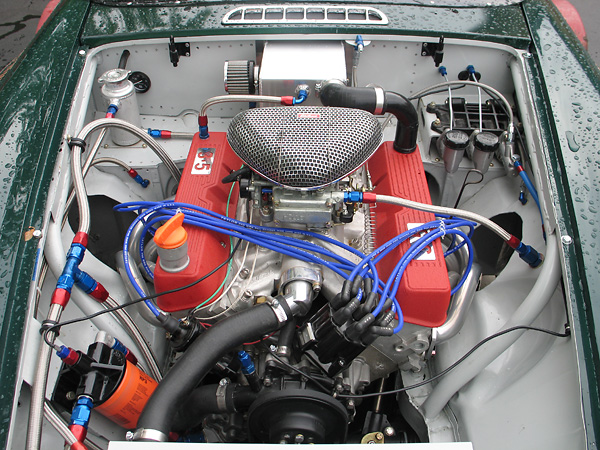
�
Tubes extend forward from the rollcage, though the firewall and forward to the frame
�
sections just forward of the motor and front suspension crossmember mounting areas.
�
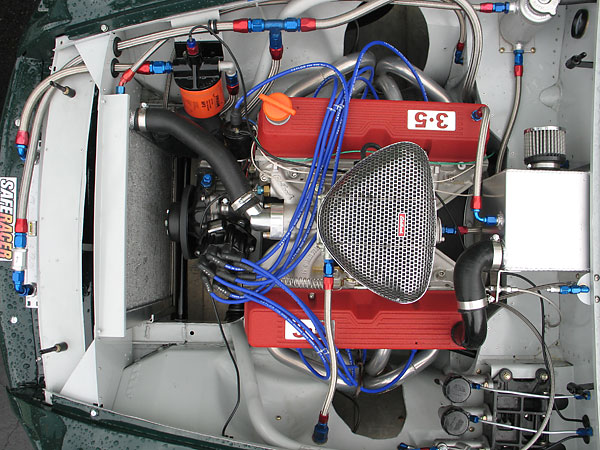
�
One distinctive feature of the MG RV8 is that exhaust headers were routed out of the
�
engine bay through holes cut in the inner wings, pretty much just as you see here.
�
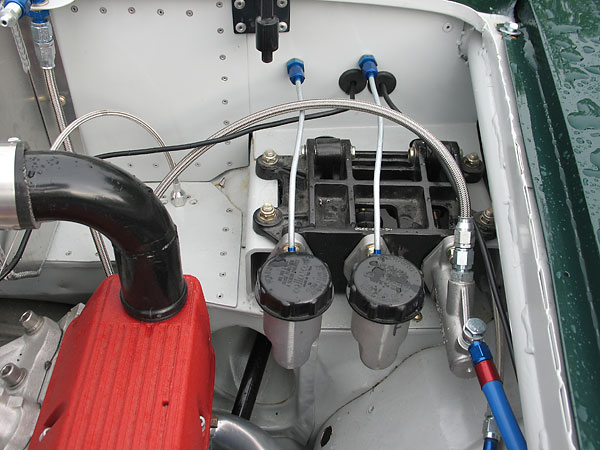
�
Wilwood pedal assembly, featuring dual master cylinders and adjustable bias bar.
�
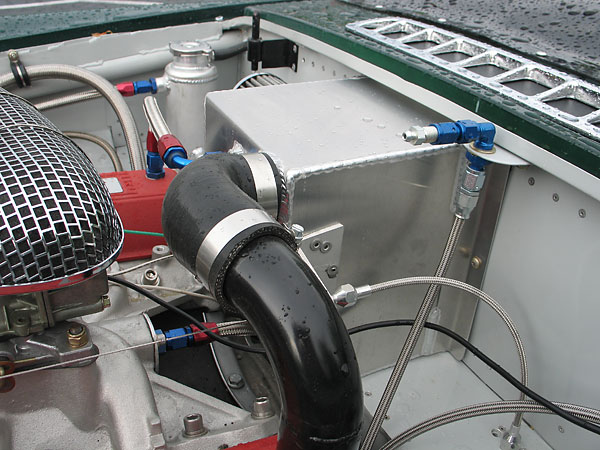
�
Custom oil breather/overflow tank.
�
(To the right, bleeder for the "hydraulic throw-out bearing" type clutch slave cylinder.)
�
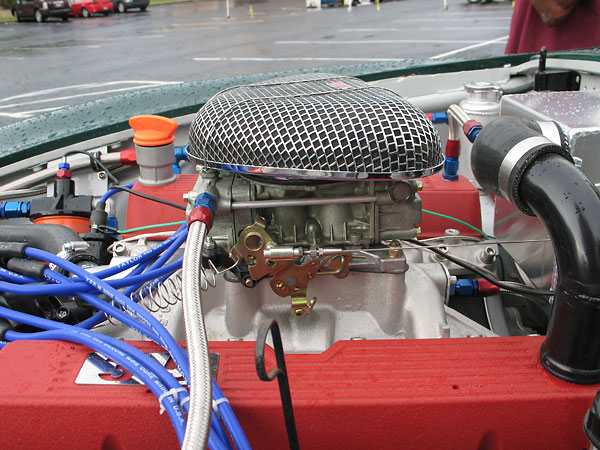
�
Holley four barrel carburetor atop an Edelbrock Performer 3.5L intake manifold.
�
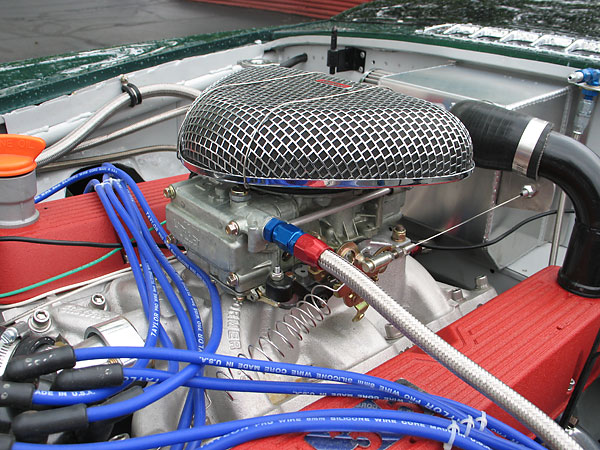
�
This Edelbrock air cleaner is fine for the paddock, but far to restrictive for serious performance
�
work. The GT2 rules permit a taller than stock hood bulge, so a large drop-base air cleaner
�
may possibly be installed at some future date.
�
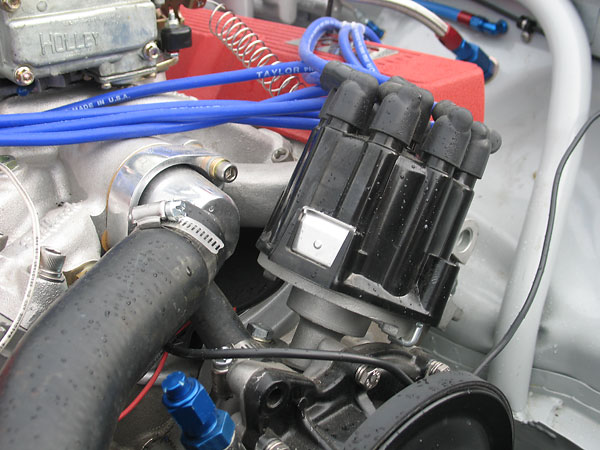
�
Delco-Remy (GM/Buick) distributor with Pertronix Ignitor breakerless module.
�
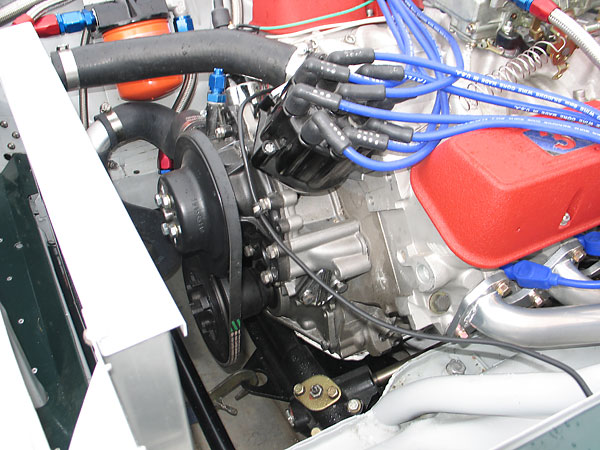
�
Taylor Pro Wire silicone 8mm spark plug wires.
�
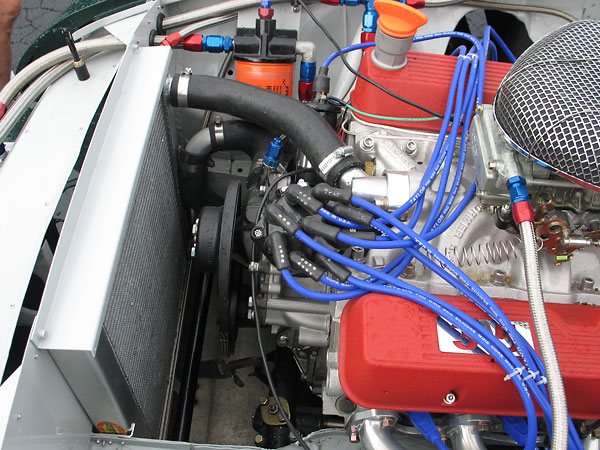
�
Saldana Racing Products custom aluminum crossflow radiator.
�
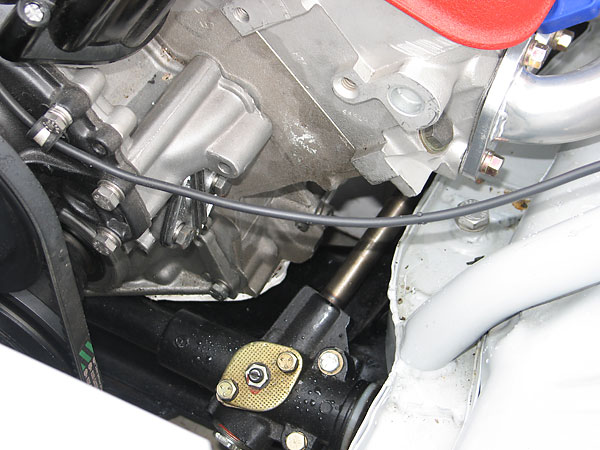
�
In its first race, oil accumulated under the engine's valve covers, then started migrating out through
�
the breather/overflow tank. Bill Young has since helped Phil install a new crankcase vent line from
�
the fuel pump blanking plate on the timing cover all the way to the breather tank. Improving the
�
ventilation system is good, but it may also be necessary to restrict oil flow to the rocker shafts.
�
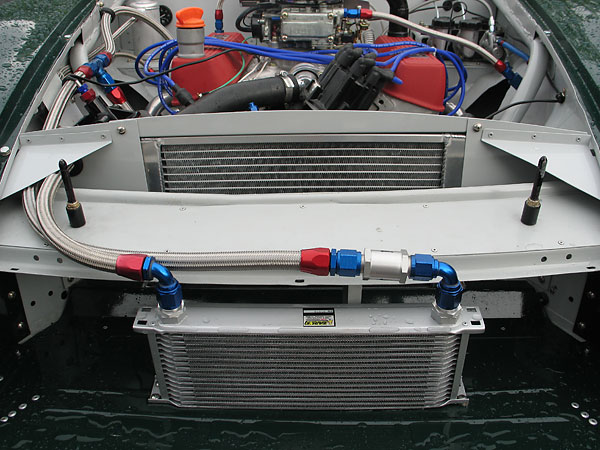
�
Earl's 16-row oil cooler (part# 81610).
�
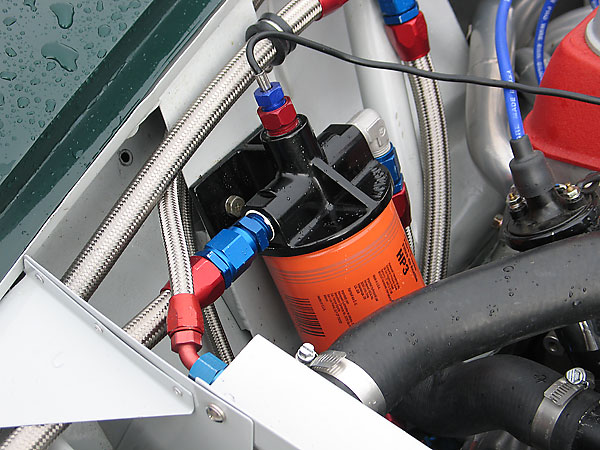
�
Fram HP3 oil filter, on a Moroso remote mount.
�
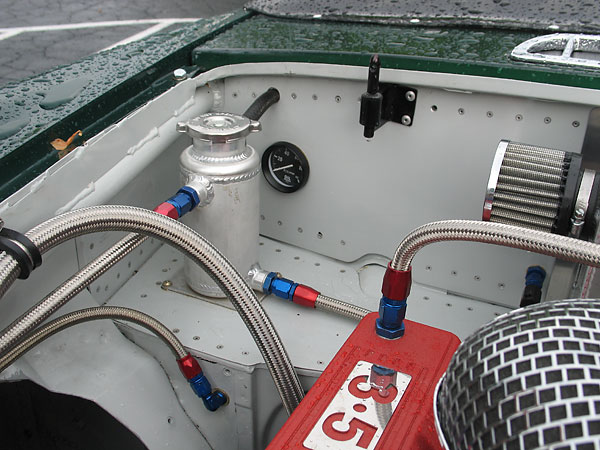
�
Aluminum coolant header tank. (An AutoMeter oil pressure gage is mounted on the firewall behind it.)
�
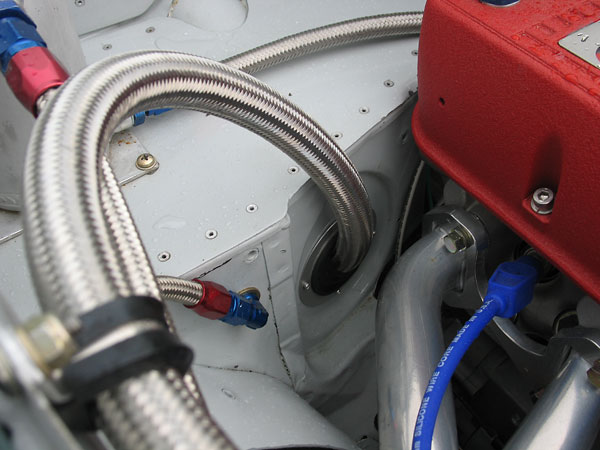
�
Oil line routing out of the engine compartment and toward the Accusump oil accumulator.
�
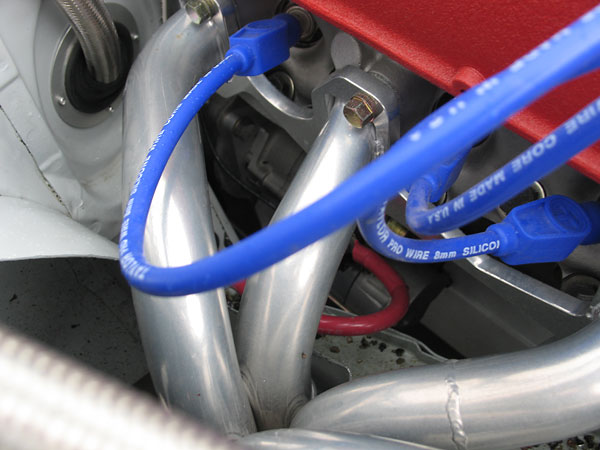
�
The MG engine compartment provides plenty of room for easy maintenance and repair.
�
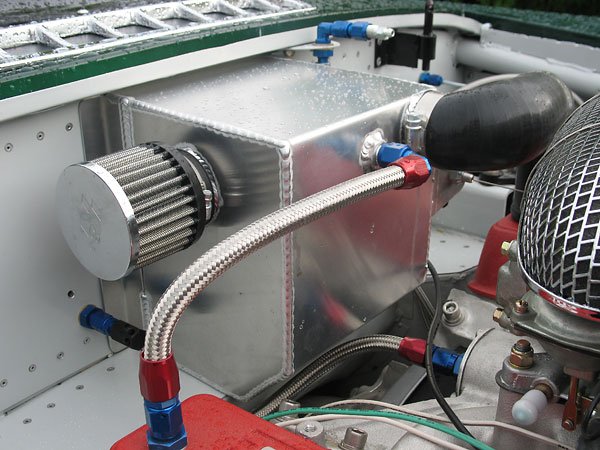
�
Saldana Racing Products built this breather tank to Clancy Schmidt's drawing.
�
(To the left, the fire suppression system's nozzle for the engine compartment.)
�
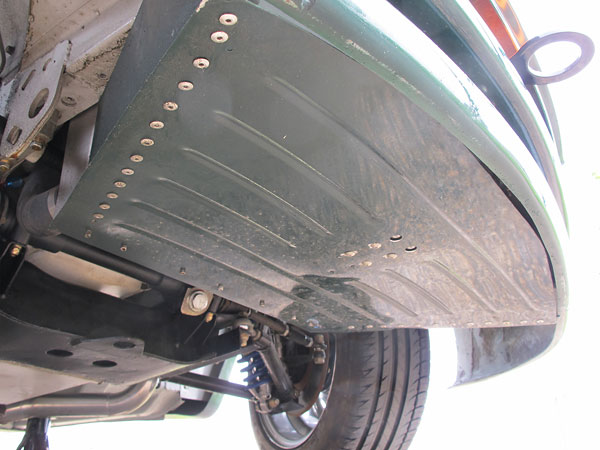
�
With excellent ductwork, Phil will get full benefit from his radiator..
�
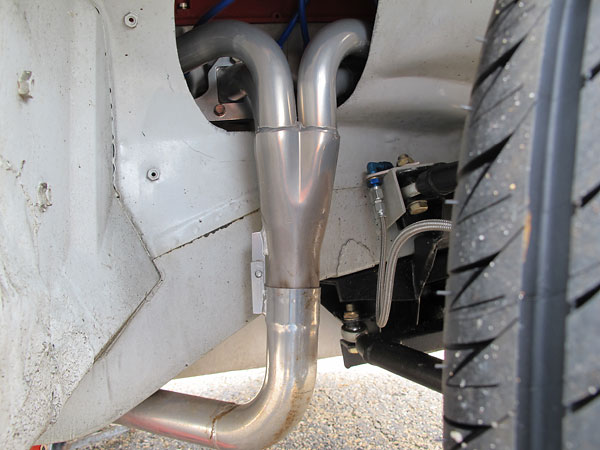
�
RV8-style (through the fender) four into one headers, ceramic coated.
�
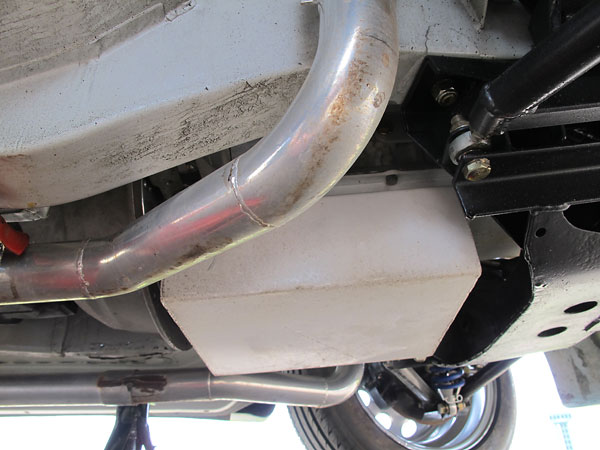
�
Custom deep sump oil pan.
�
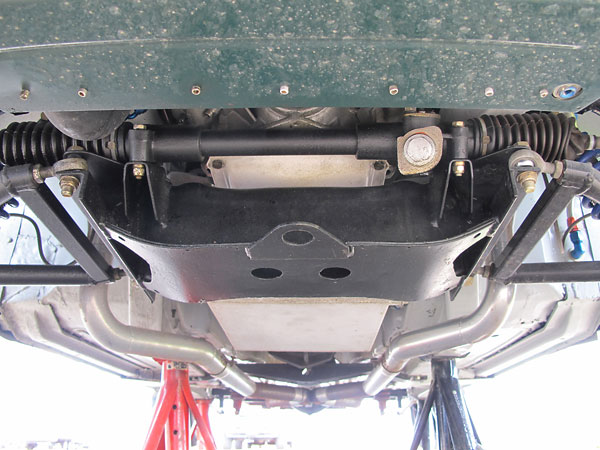
�
An X-pipe in the exhaust system should both improve performance and mellow the exhaust tone.
�
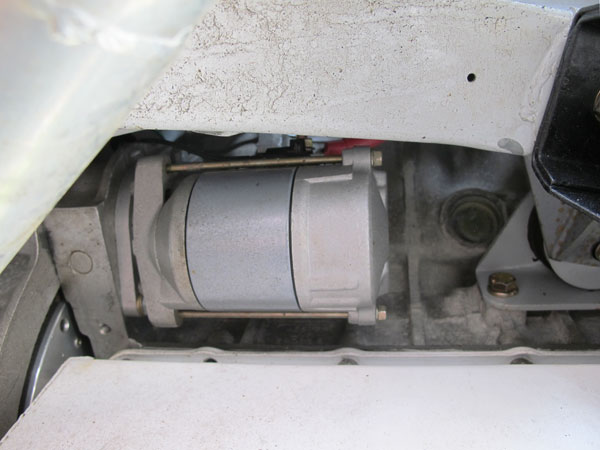
�
Lightweight gear reduction starter from BritishStarters.com
�
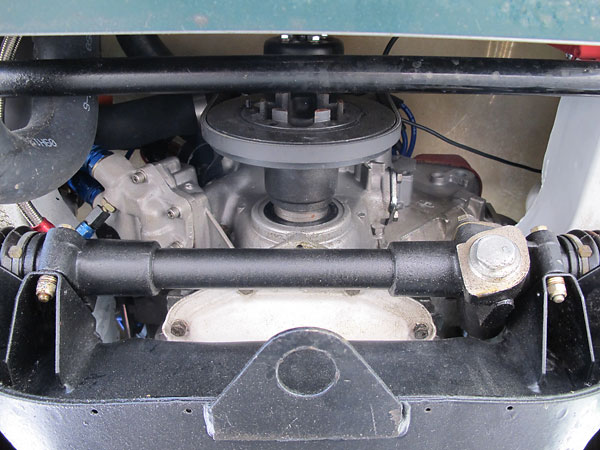
�
Modifier harmonic balancer. (One groove has apparently been removed from the crankshaft pulley.)
�
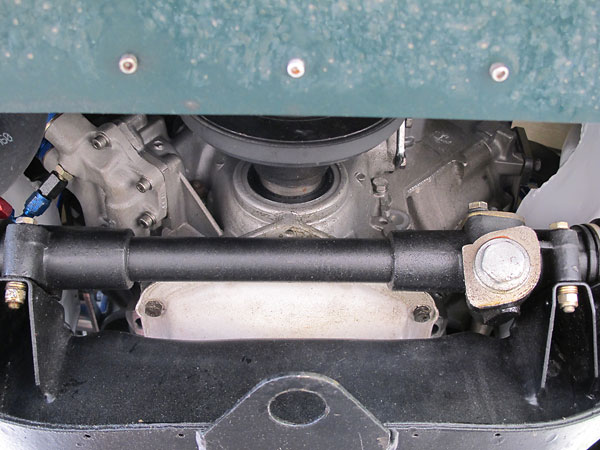
�
Flotec low profile oil pump base.
�
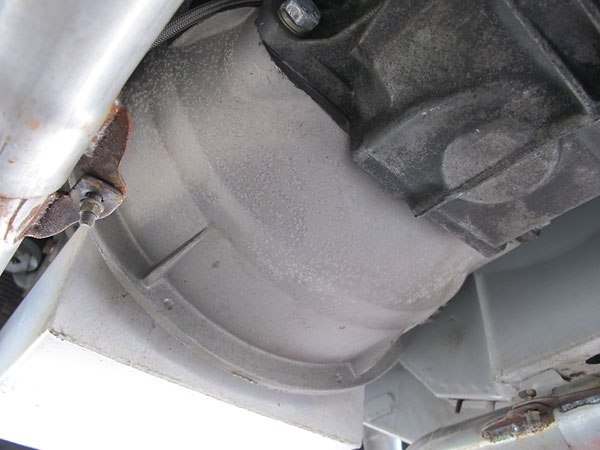
�
An aluminum bellhousing mates the Chevy-pattern T5 five-speed to the Rover V8's rear flange.
�
�
Fuel System
��
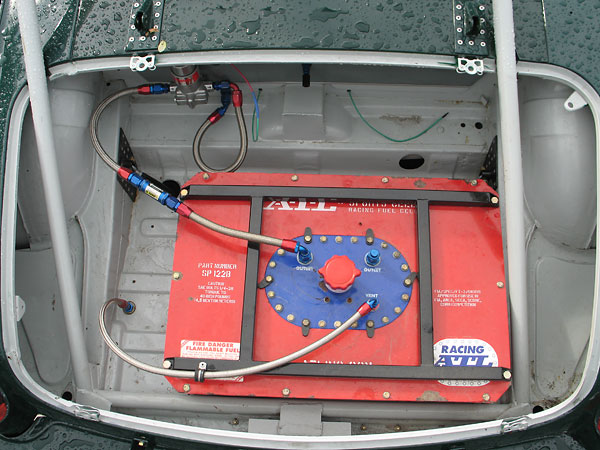
�
ATL Sportsman 22-gallon steel canister fuel cell (part# SP122B).
�
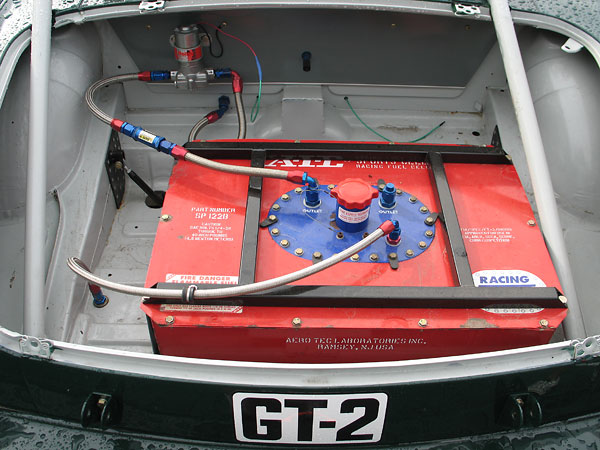
�
The steel canister isn't deemed enough by itself. A beefy box-tube frame clamps it down.
�
Note also the black sprayer nozzle of the fire suppression system.
�
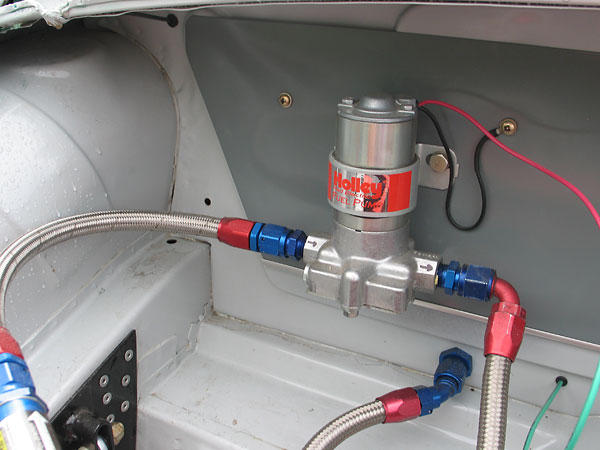
�
Holley "red" electric fuel pump. (In the photos above, you can see that the car has
�
also been wired for a second fuel pump which hasn't yet been installed.)
�
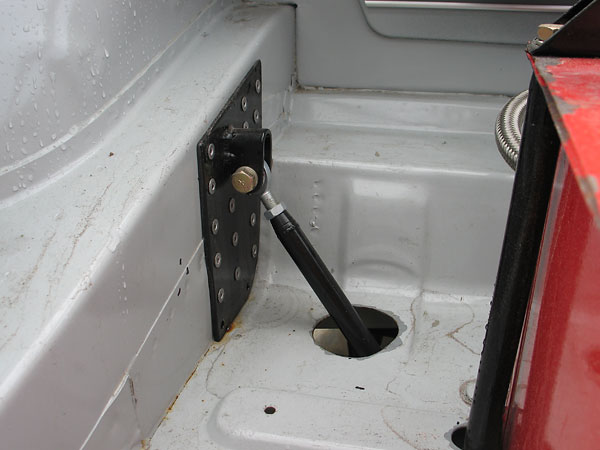
�
This link seems to reach down to help support the weight of the fuel cell.
�
More importantly, it reinforces the mounting bracket for a planned anti-sway bar.
�
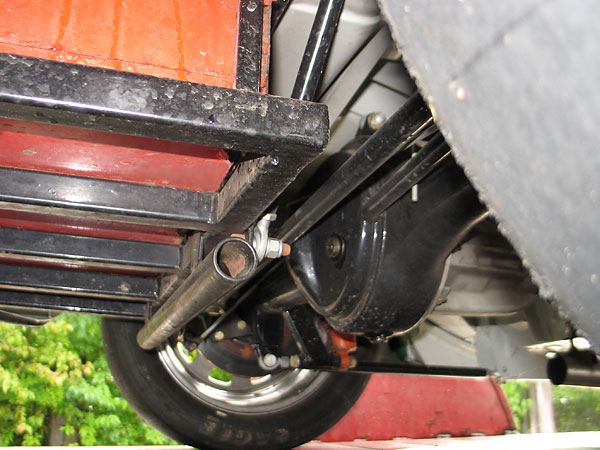
�
The fuel cell sits atop an exceptionally robust frame. The round tube below the
�
fuel cell awaits installation of a Schroeder three-piece anti-sway bar.
�
 �
�
�
�
Front Suspension
��
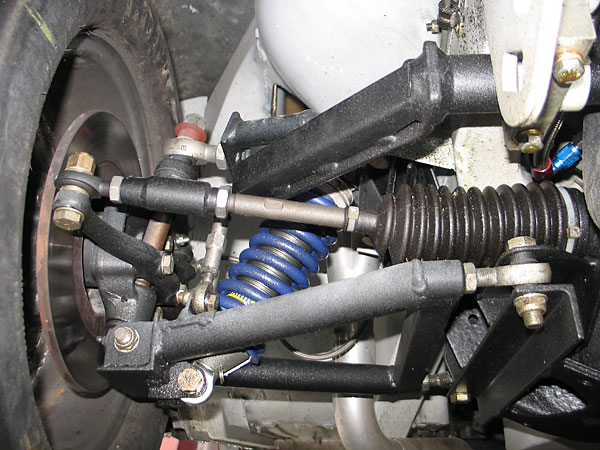
�
The MG RV8 model's front suspension and brakes were subtantially upgraded from the MGB.
�
Here, however, we find a racing suspension that only uses a few components from the MGB.
�
The fundamental geometry of the suspension is radically different, with inboard wishbone
�
pivots in particular relocated to provide very different camber change characteristics.
�
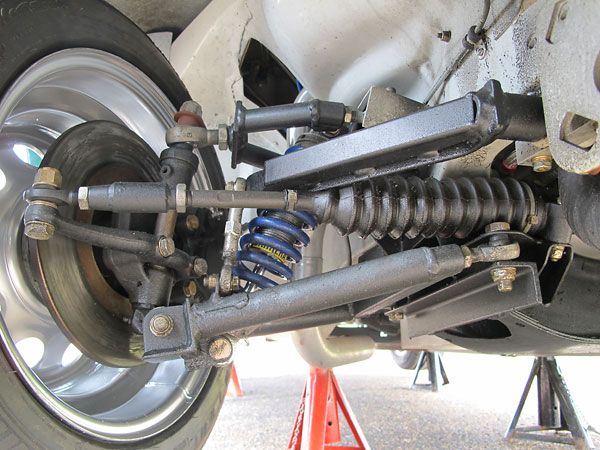
�
Carrera coilover shock absorbers.
�
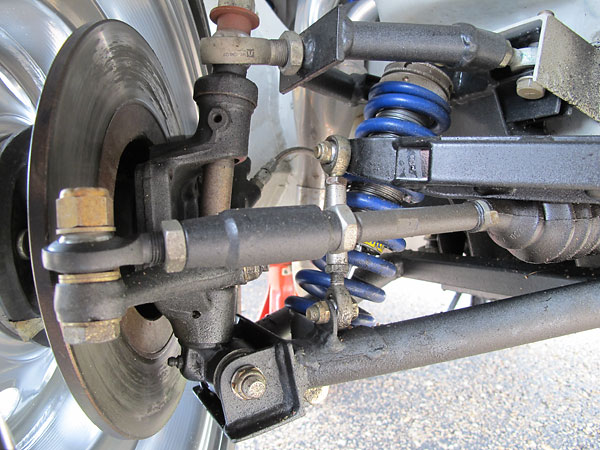
�
Roll / bump steer adjustment has been facilitated by eliminating the tapered joint between
�
steering arm and tie rod end, in lieu of a standard Heim joint which may easily be shimmed
�
upward or downward.
�
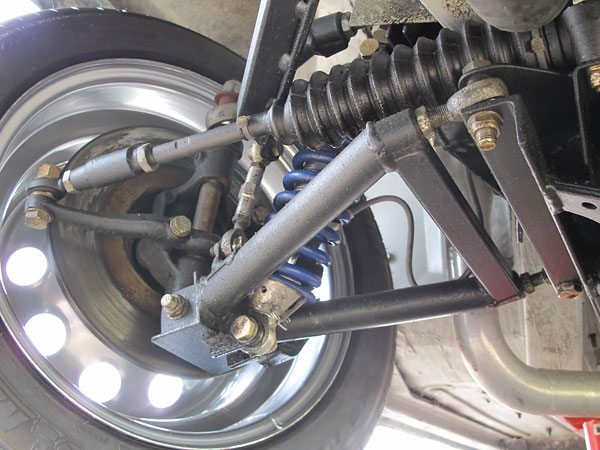
�
Zerk fittings and grease seals on the upright were missing when we photographed
�
this car, but they'll be reinstalled soon.
�
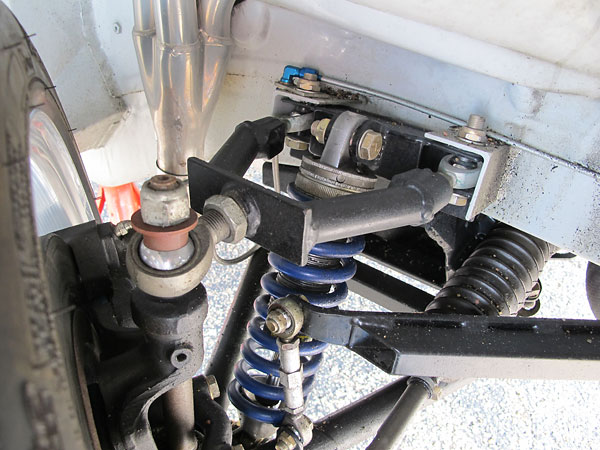
�
This front suspension was originally made by Dave Headley at Fab-tek, but it's been
�
extensively reinforced by Clancy Schmidt, particularly both above and below where the
�
upper control arms mount to the frame. The upper control arms will soon be upgraded to
�
ones that eliminates the outboard Heim joint (and its inevitable associated stress risors)
�
in lieu of a more robust design featuring a spherical bearing set into a cup.
�
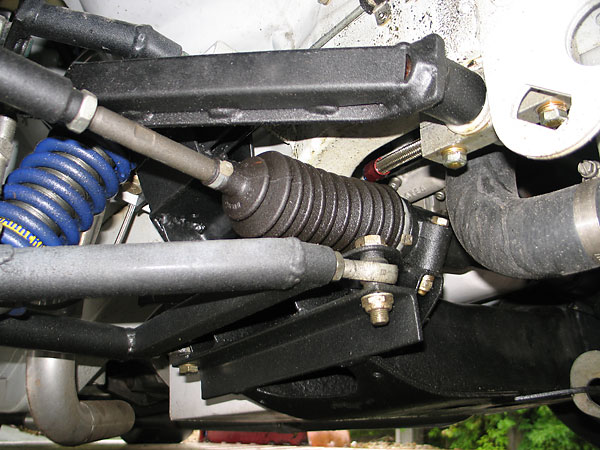
�
Fab-tek anti-sway bar on aluminum pillow blocks.
�
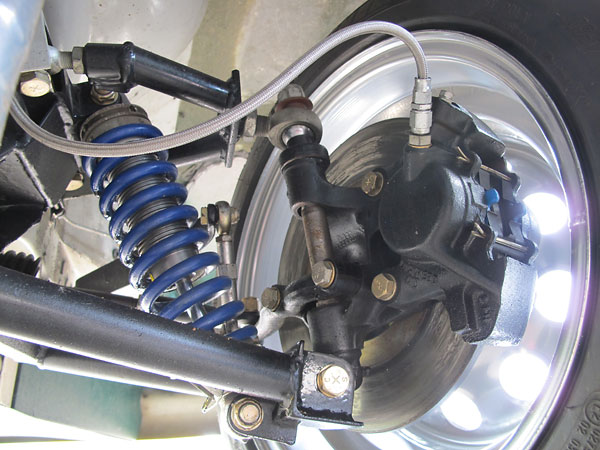
�
The production MG RV8 had beefy vented brake rotors, and this racecar certainly will too
�
before many races are run. GT2 rules are particularly unrestrictive with regard to brakes. Here:
�
stock MGB (Lockheed) iron brake calipers and thin solid rotors, with Hawk "blue" brake pads.
�
Phil & Clancy plan to upgrade to Wilwood 4-piston aluminum calipers and 10.25" vented rotors.
�
�
Enjoying this article? www.BritishRaceCar.com is partially funded through generous support from readers like you!
�
To contribute to our operating budget, please click here and follow the instructions.
�
(Suggested contribution is twenty bucks per year. Feel free to give more!)�
Rear Suspension
��
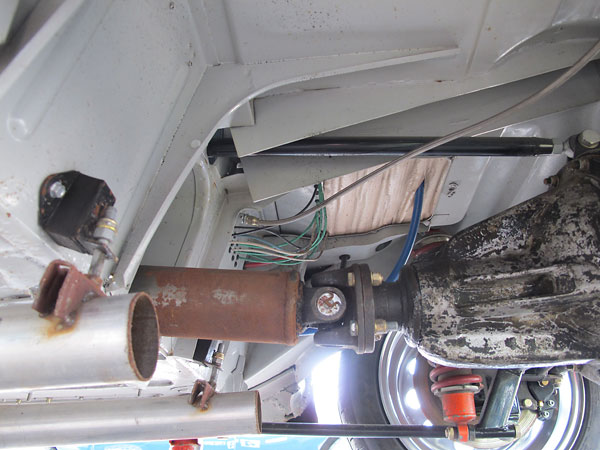
�
Custom three link rear suspension.
�
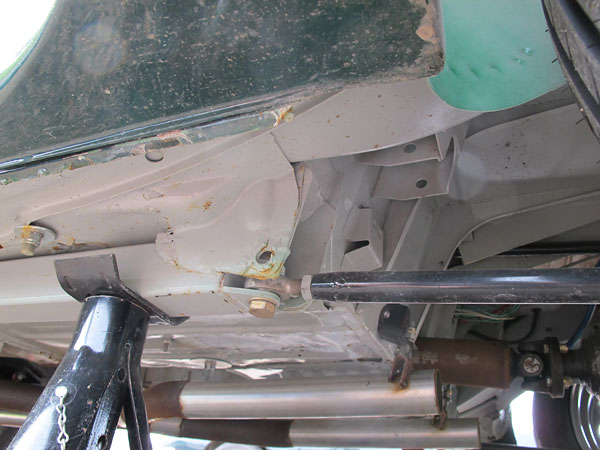
�
Instead of attaching the lower links to the MGB's stock front leafspring brackets, Clancy has them tied
�
into stout brackets on the end of 2" box tube reinforcements which continue forward underneath the
�
floorboards. He says, if he were doing it again he'd orient the mounting bolts on a horizontal axis.
�
That little change might faciilitate greater suspension travel.
�
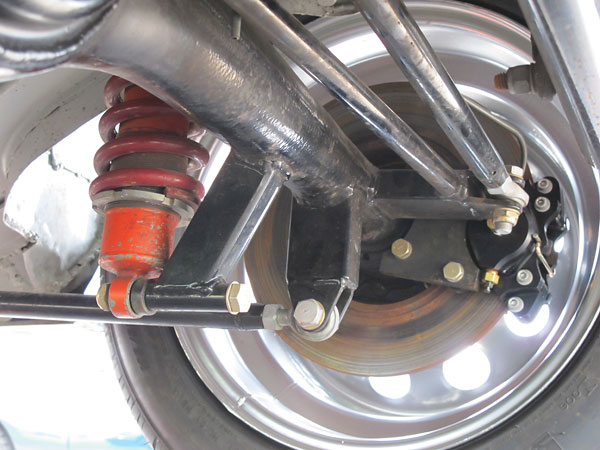
�
Panhard rod attachment to the MG "banjo" style axle. Banjo axles were used on MGA and on MGB cars,
�
until the company introduced the MGB GT model in ~1965. They're usually preferred for MGB racecars
�
because of their light weight. There's no way these axles are robust enough for a V8 powered racecar;
�
and this banjo axle was replaced with a Ford 8" based axle after just one race weekend.
�
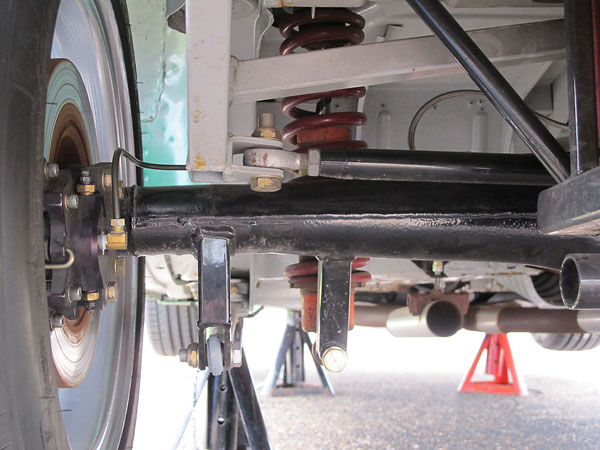
�
Panhard rod attachment to the MG RV8 bodyshell.
�
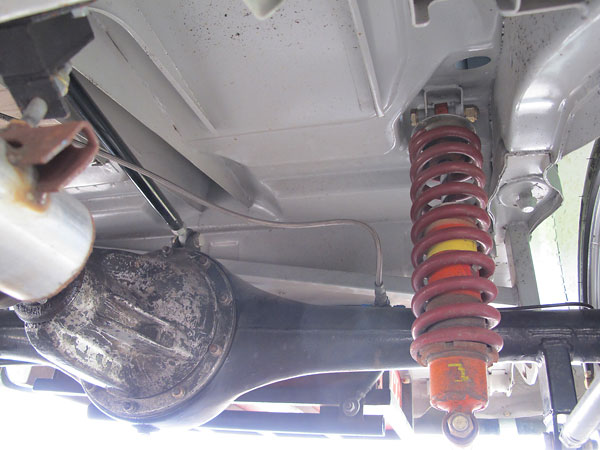
�
These Koni coilover shock absorbers were adequate for the initial outing, but will be replaced
�
with new, more adjustable shocks as part of the sorting-out process. Rear anti-sway bar
�
attachments have been added since this photo. A bar will be installed for the second outing.
�
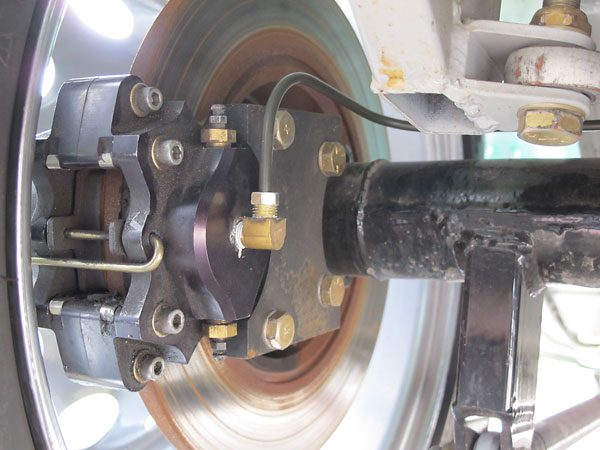
�
These small Wilwood 2-piston aluminum rear disc brake calipers are a big upgrade over stock MGB
�
drum brakes, yet Phil and Clancy will go a couple sizes bigger on the new axle. When the current
�
system was tried-out by Jesse Prather at Heartland Park, it proved well balanced and effective, but
�
that was over a short sprint. To be competitive through an entire forty-five minute GT2 race, the RV8
�
will need much more brake capacity than, for example, an F-Production MGB racecar.
�
�
�
The following three photographs have been provided by newly appointed Crew Chief, Bill Young.
�
(Copyright 2011 by Bill Young for BritishRaceCar.com. All rights reserved.)�
�
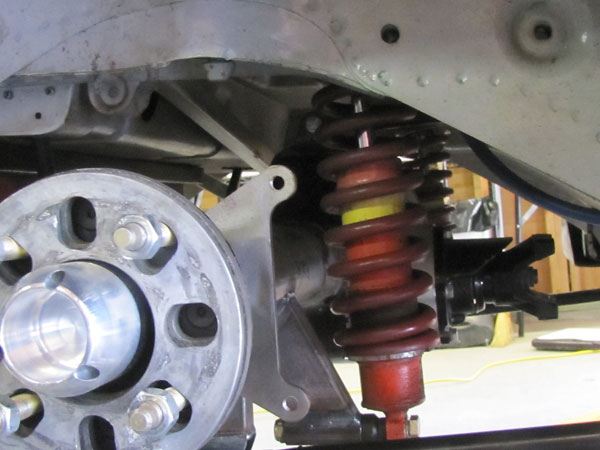
�
Initial installation of Phil's new Speedway Engineering "Mini Stock" axle. It's nominally a Ford 8" axle,
�
but lighter and much stronger. It also differs from a passenger car axle in that its lightweight, rifle drilled
�
driveshafts are splined at both ends and bear no responsibility for keeping hubs and wheels from
�
moving inward or outward. (The axle will be removed and powdercoated before final assembly.)
�
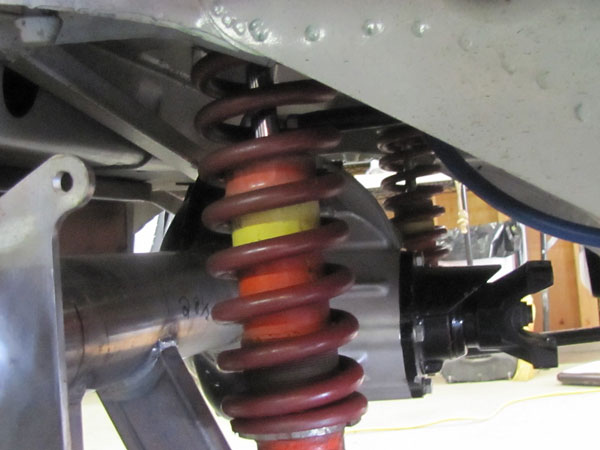
�
The axle's Curry aluminum gear carrier is lighter than Ford's iron carrier. It currently supports a
�
3.8:1 ring and pinion set, and a Ford limited slip differential.
�
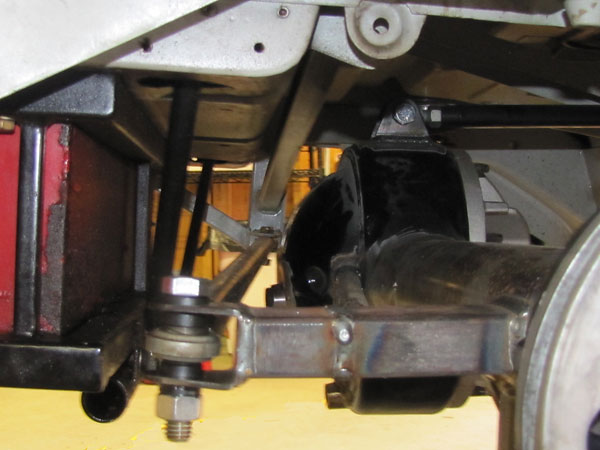
�
Mounting features are copied over from the earlier axle installation, so the three link suspension and
�
Panhard rod didn't need to be re-engineered. Shocks, springs and brakes will be updated soon.
�
�
�
Interior / Roll Structure / Etc.
��
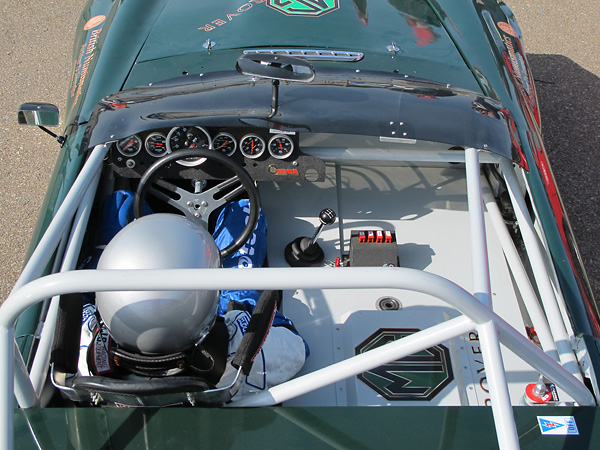
�
On a modern racecar, safety is of paramount importance. In addition to an SCCA mandated
�
Head and Neck Support (HANS) collar, here you can see head supports bolted onto the seat.
�
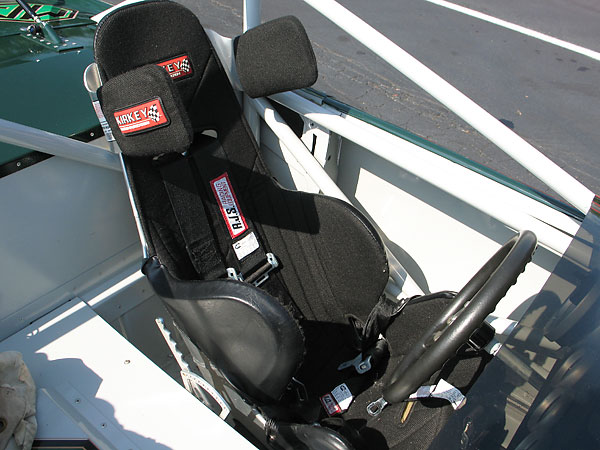
�
Kirkey aluminum racing seat.
�
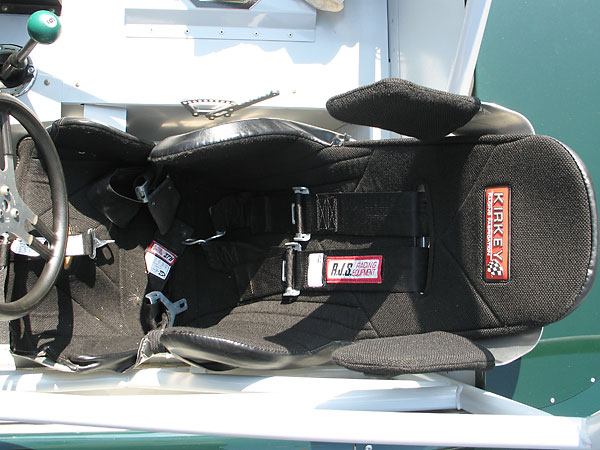
�
RJS Racing Equipment five point latch and link safety harness.�
�
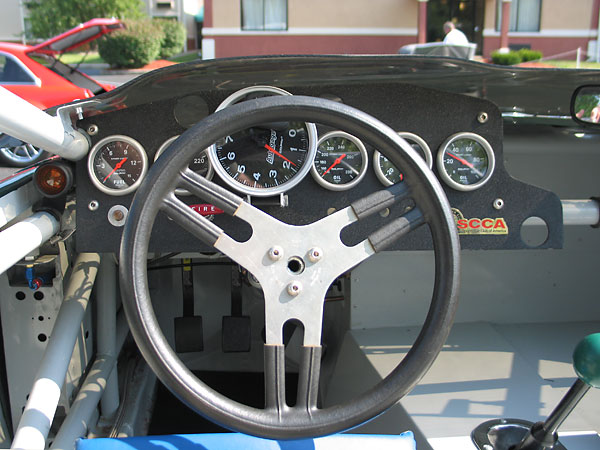
�
Sweet Manufacturing aluminum steering wheel.
�
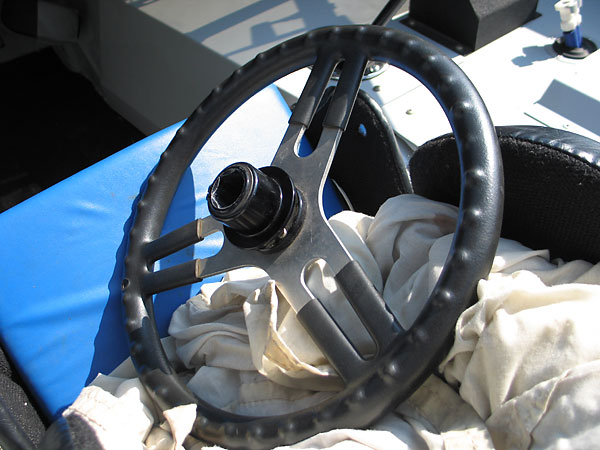
�
Sweet Manufacturing quick release hub. (This is an important safety feature too!)
�
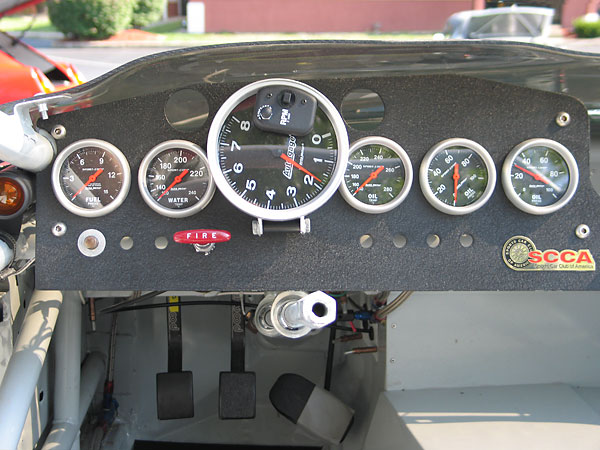
�
AutoMeter fuel pressure (0-15psi), water temperature (120-240F), tachometer (0-8000rpm),
�
oil temperature (140-280F), engine oil pressure, and AccuSump oil pressure (0-100psi) gauges.
�
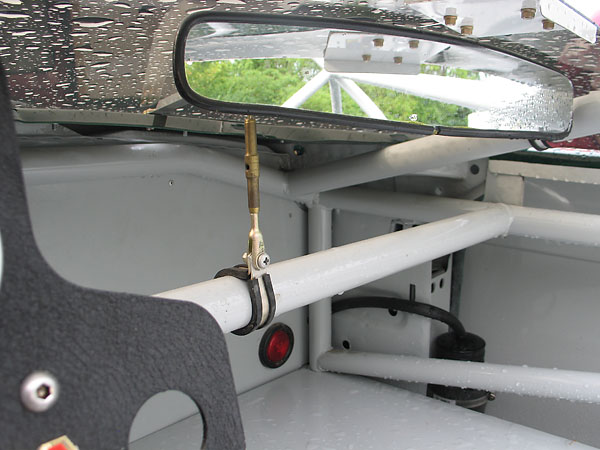
�
This positioning of the rear view mirror was slick, but it turned out to be too low. Now, a "Sports 2000"
�
style mirror mounted above the windscreen provides a clearer view. In the background, the red light
�
indicates "ignition on". Clancy plans to add a second light next to it, to indicate loss of oil pressure.
�
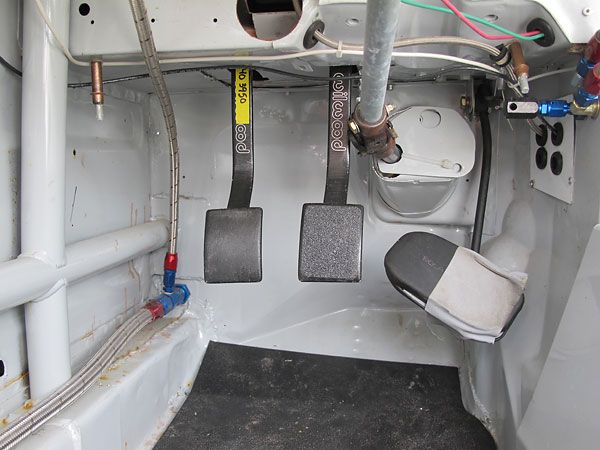
�
A temporary extension on the throttle pedal makes heel-and-toe driving a little easier.
�
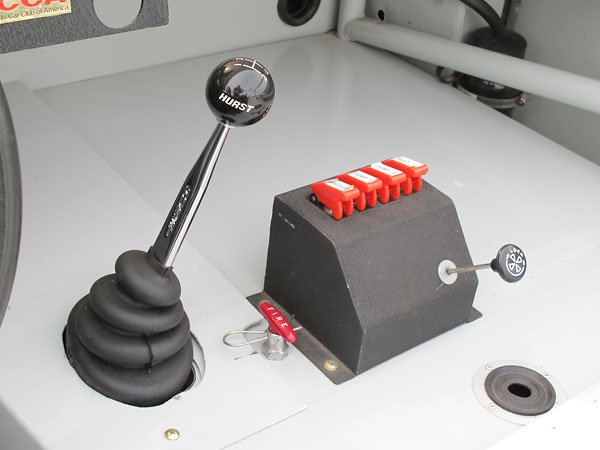
�
Hurst shifter. Switches, left to right, are for ignition, fuel pump one, fuel pump two, and Cool Suit.
�
The black knob controls an Accusump oil accumulator (It will soon be replaced with something more robust.)
�
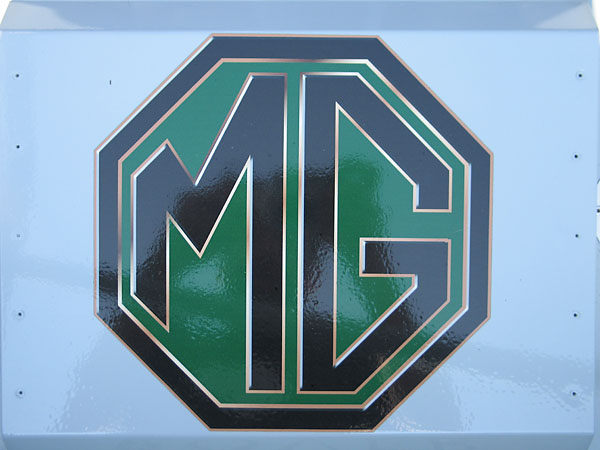
�
Large MG logo sticker.
�
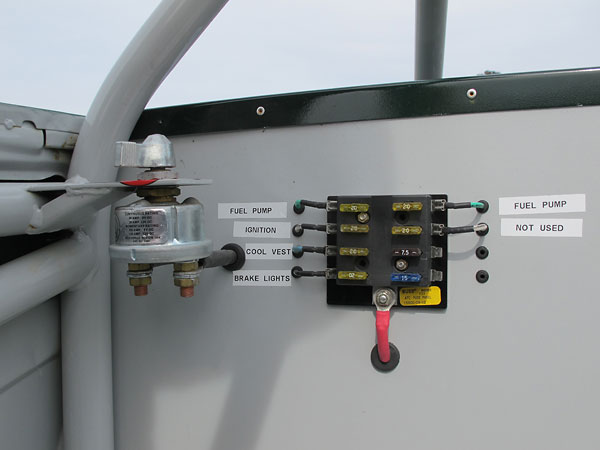
�
Cole-Hersee battery disconnect switch (model 2484). Buss ATC fuse panel, with fuses for two fuel pump
�
circuits, the ignition, the Cool Vest, and the brake lights. (Three fuse positions are unused.)
�
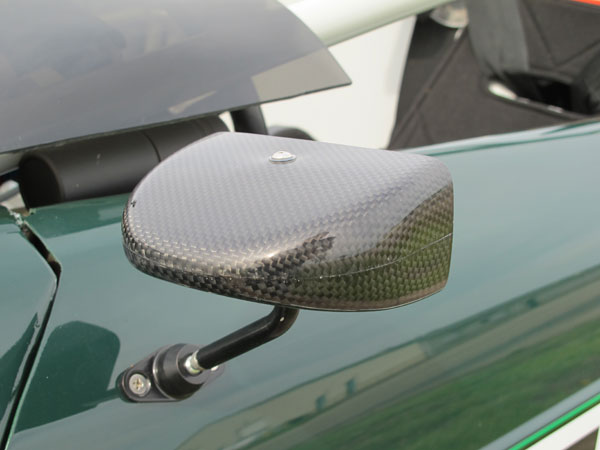
�
Carbon fiber side view mirror.
�
�
Exterior
��
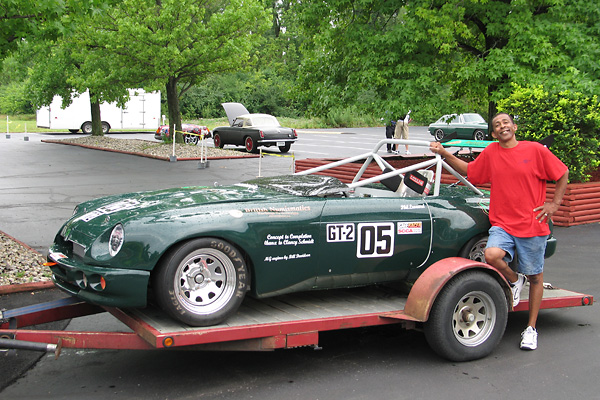
�
Robert Maupins brought Phil's MG RV8 to the BritishV8 2010 meet in Indianapolis.
�
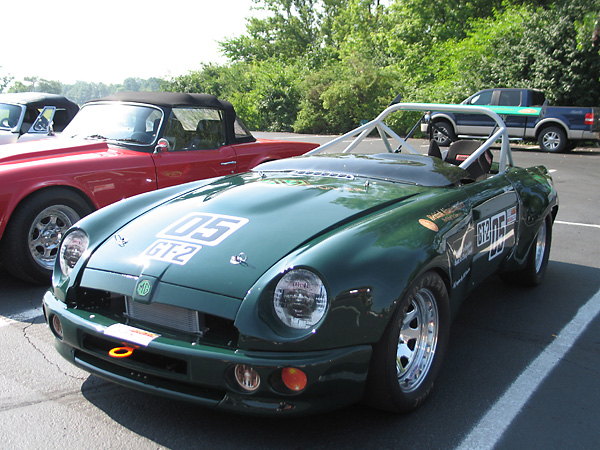
�
MGBs and RV8s are unibody cars with removeable steel front fenders and welded-in rear quarterpanels.
�
Phil had purchased a Speedster Body Kit from Dave Craddock of Preform Resources, with generously
�
flared lightweight fiberglass front and rear fenders. However, the speedster kit was engineered to suit an
�
SCCA production-class MGB racecar. For GT2, even wider flares are needed. On the other hand, cosmetic
�
changes were needed to replicate the MG RV8 appearance. Mark Canaday of the A+ Collision bodyshop
�
in Topeka widened the Preform racing fenders, spliced in RV8-style headlight and taillamp sections, etc.
�
Please support the sponsoring companies who make www.BritishRaceCar.com possible, including:
� �
 �
�
�
�
�
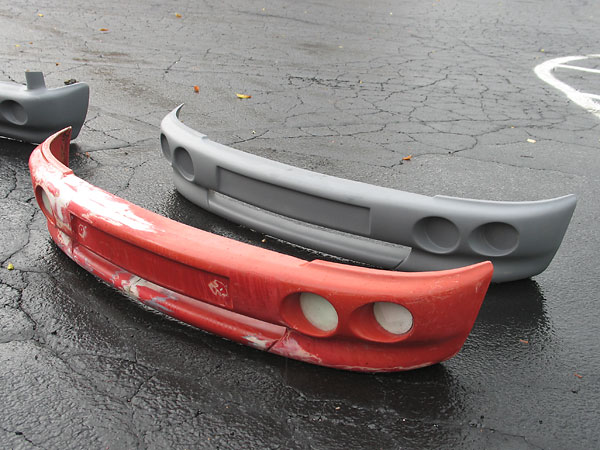
�
An original (slightly damaged) MG RV8 front bumper, and a fiberglass replica made from it
�
by Mark Funk of Kansas City, who also replicated the RV8 bonnet extension (shown next, below).
�
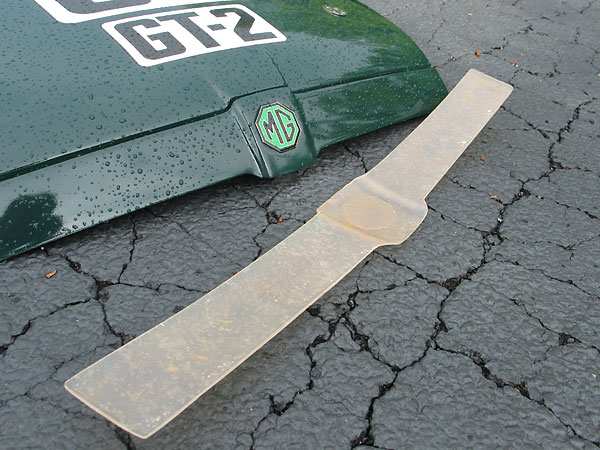
�
The fiberglass piece in the foreground here is a "negative" of the actual part, shown painted in background.
�
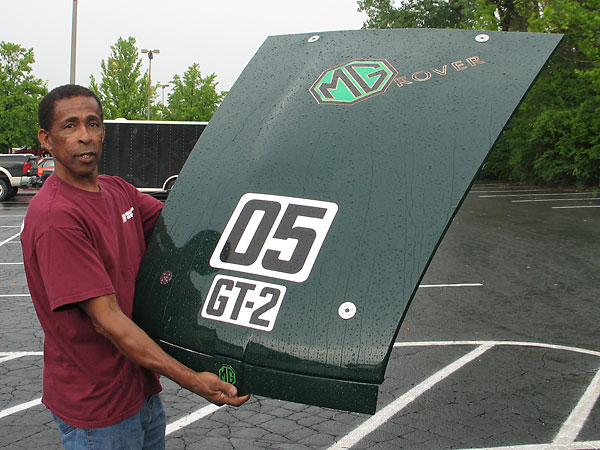
�
Lightweight fiberglass MG RV8 bonnet, with four mounting holes for hood pins.
�
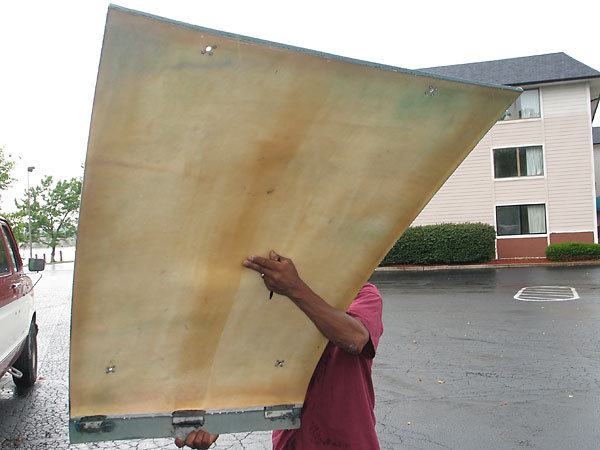
�
For racing, it's feasible to build body parts like this with very minimal reinforcement.
�
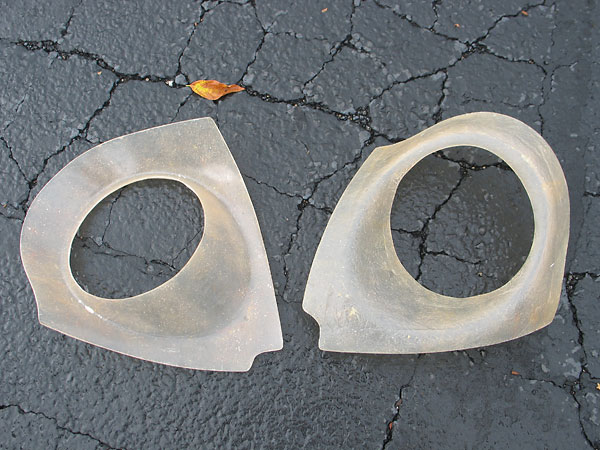
�
A spare set of headlight surrounds.
�
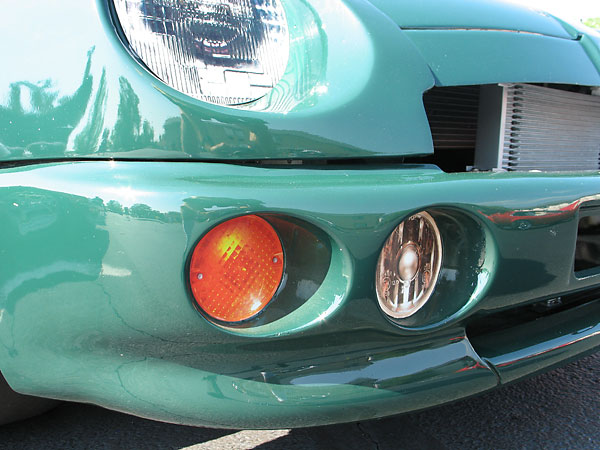
�
Headlight surround, installed.
�
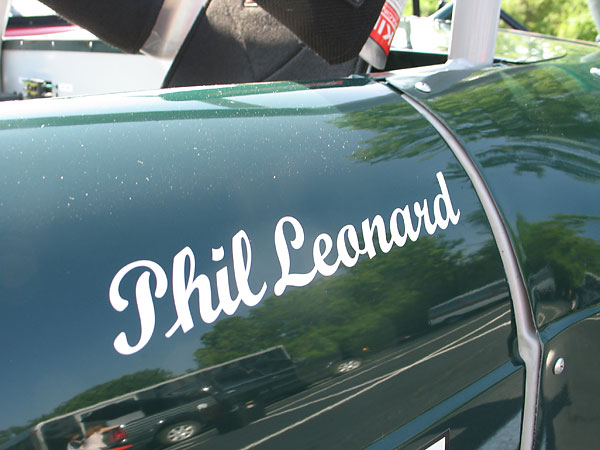
�
Phil Leonard (owner/driver)
�
Paint job and lettering by Mark Canaday of A+ Collision of Topeka.
�
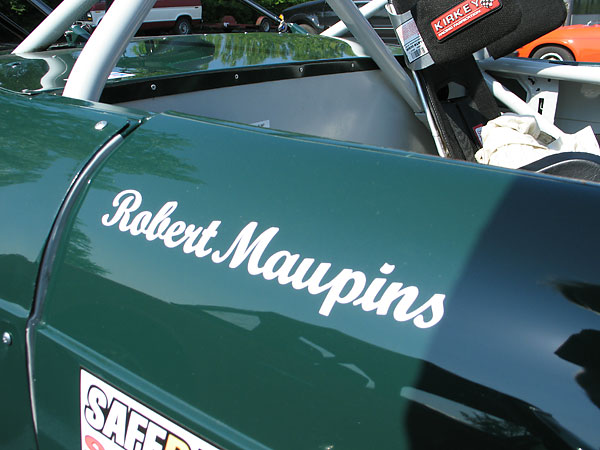
�
Robert Maupins (driver)
�
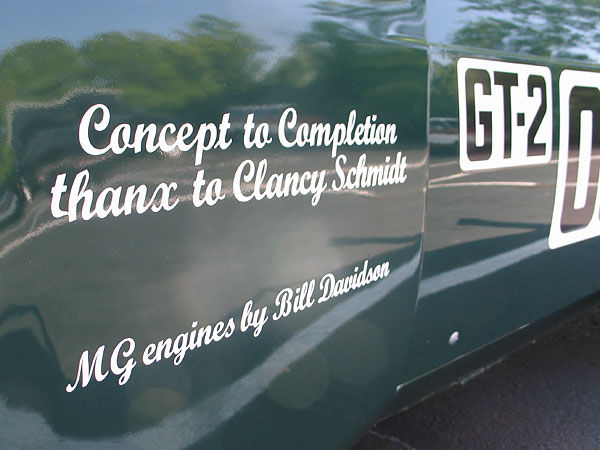
�
Concept to Completion thanx to Clancy Schmidt,
�
MG engines by Bill Davidson.
�
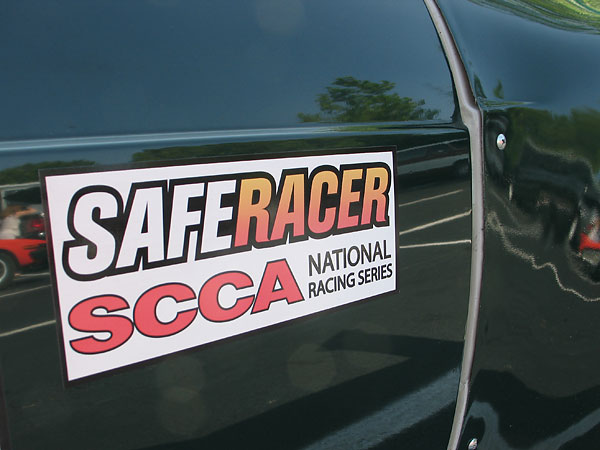
�
SafeRacer SCCA National Racing Series
�
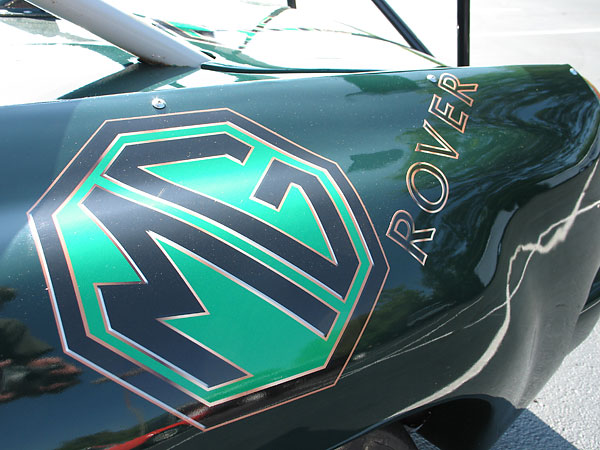
�
Generously sized fender flares and bodywork made conveniently removeable are two
�
typical features of SCCA "GT" class racecars.
�
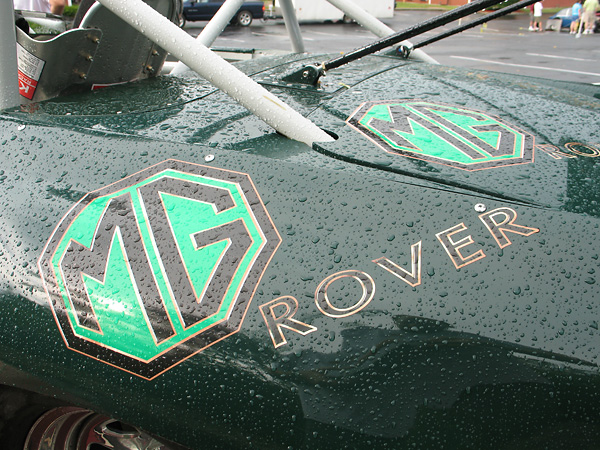
�
This car's livery was evidently inspired by the MG-Lola EX257 prototype racecars which raced
�
in the 2002 24 hours of LeMans. MG Rover Group teamed with Lola to create a these full-tilt
�
endurance racers. Ultimately, EX257 model was actively raced from 2001 to ~2007. The 2002
�
"X-Power" paint and decal scheme is particularly memorable.
�
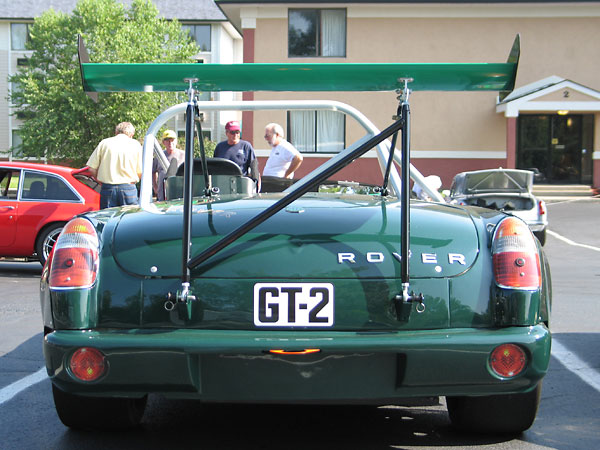
�
Cosmo Racing "Aluminum GT Wing" single deck / single wing spoiler, 130cm (part# W63FSS).
�
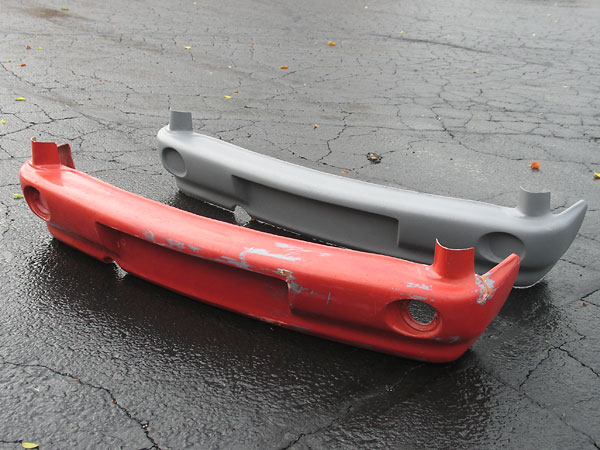
�
An original (slightly damaged) MG RV8 rear bumper, and a fiberglass replica made from it.
�
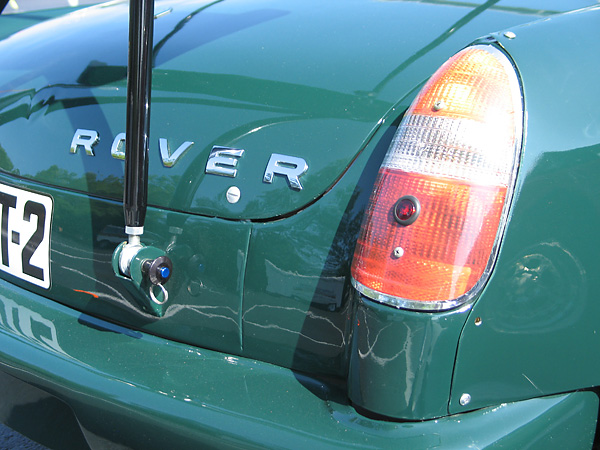
�
Since original MG RV8 taillamps are scarce and costly, Phil will use homemade replicas for racing.
�
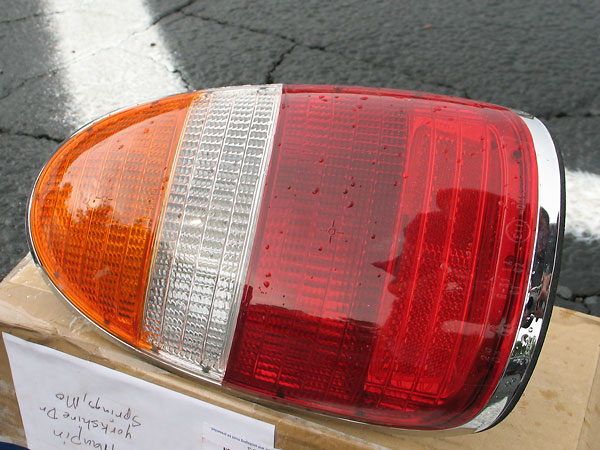
�
To make authentic replicas, Phil first bought the real deal: complete MG RV8 taillamp assemblies.
�
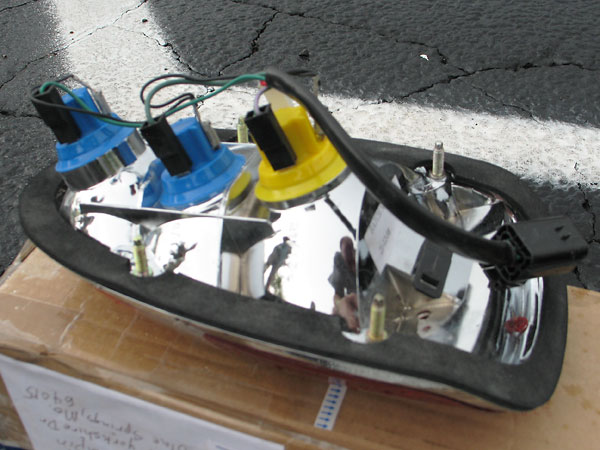
�
Bulbs are serviced from the rear, without lens removal.
�
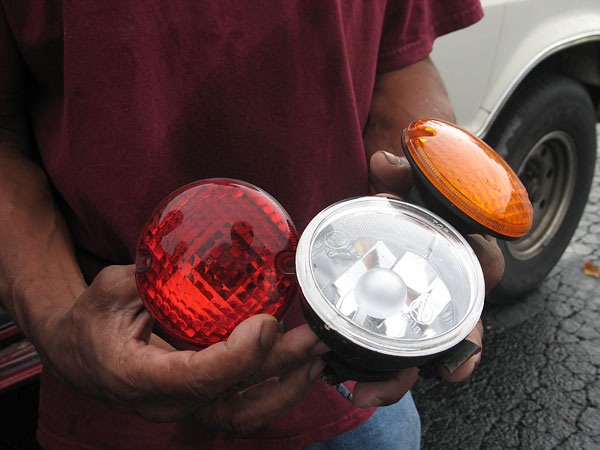
�
Here's a handful of original MG RV8 parking, turn signal, and driving lights.
�
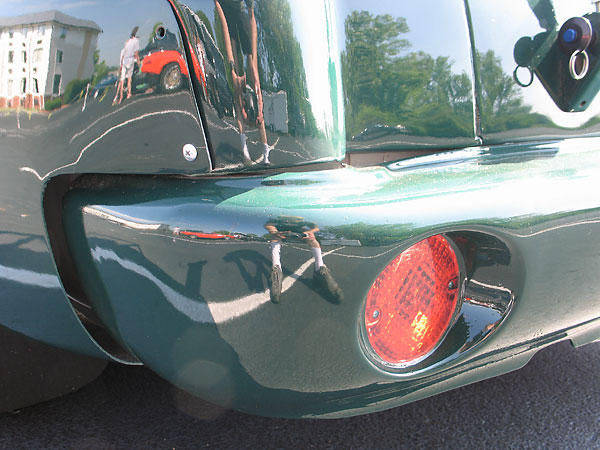
�
With original RV8 lamps in hand, the team could create accurate and convincing replica decals.
�
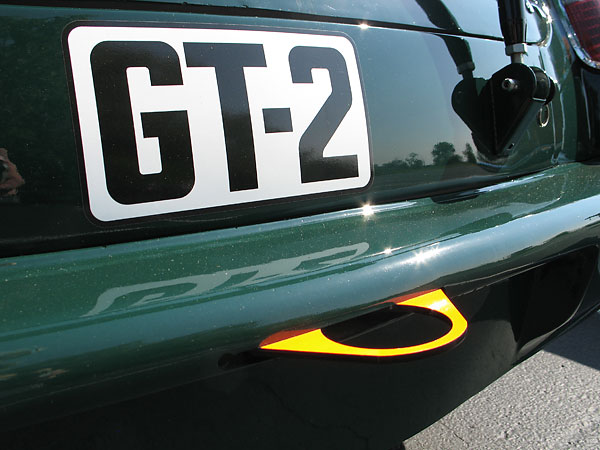
�
GT-2 decal.
�
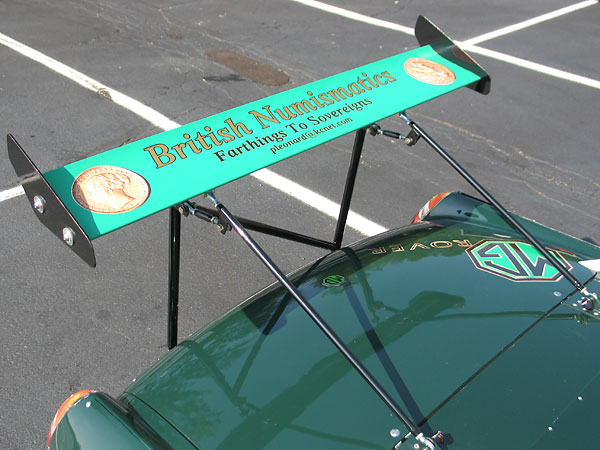
�
British Numismatics - Farthings to Sovereigns
�
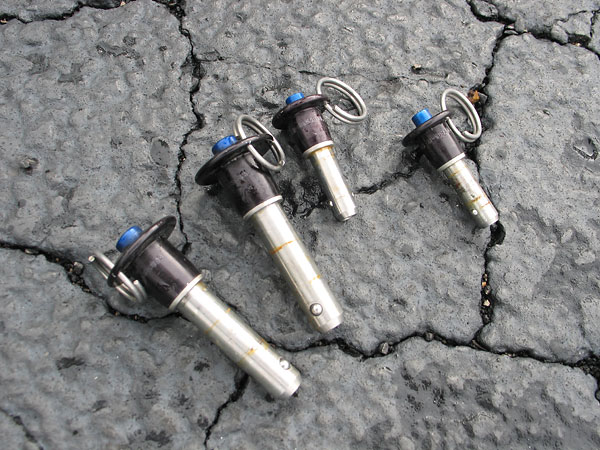
�
Pip pins.
�
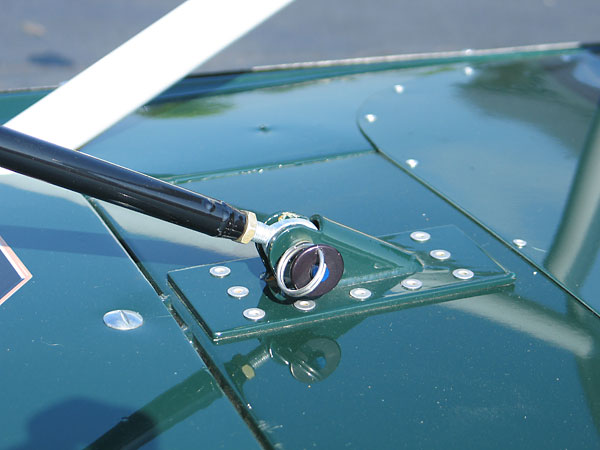
�
When the blue pushbuttons of these "pip pins" are pressed, they can be installed or removed.
�
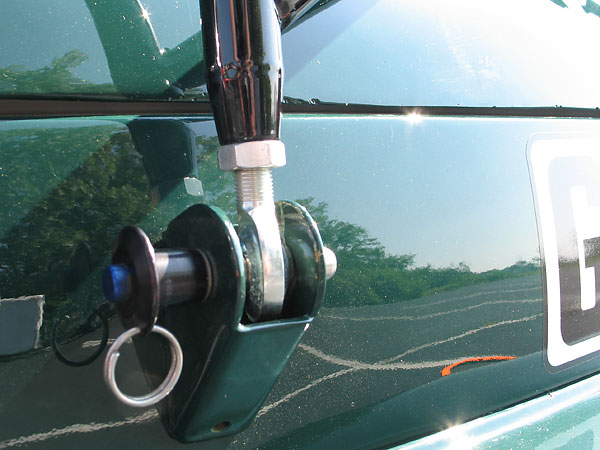
�
Pip pins are strong in shear, yet quickly removeable.
�
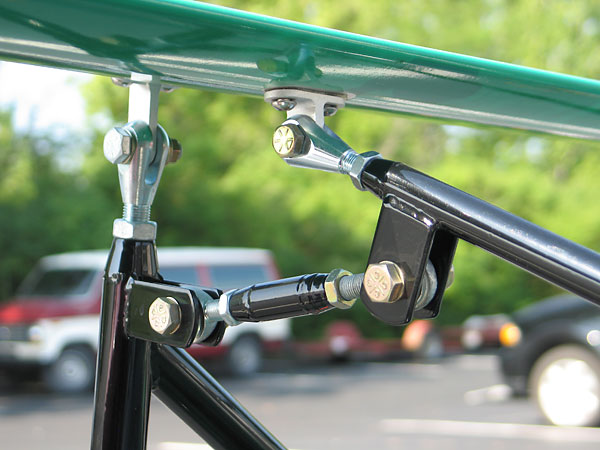
�
Adjustablity.
�
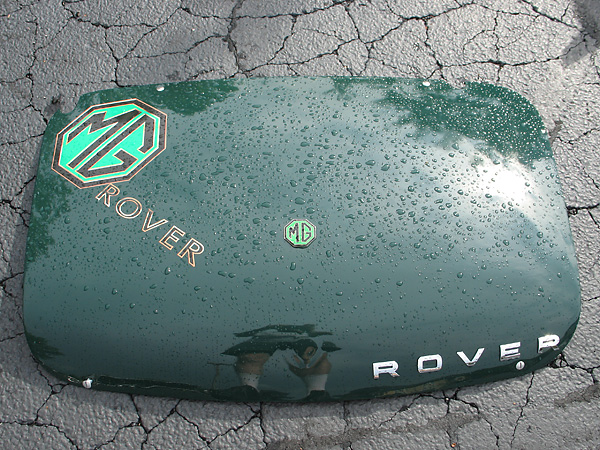
�
Lightweight fiberglass boot lid.
�
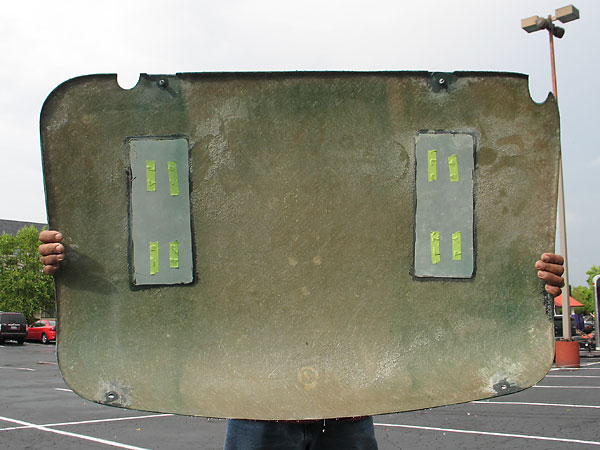
�
Instead of a pushbutton operated latch and hinges, the fiberglass boot lid is
�
attached to the car with four quick-release (quarter-turn) fasteners.
�
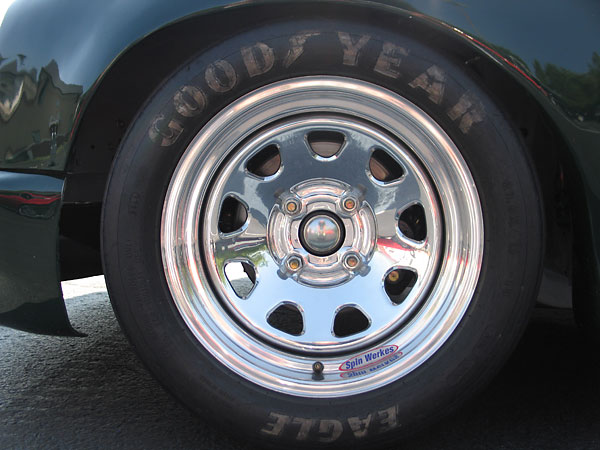
�
Spin Werkes lightweight aluminum racing wheels.
�
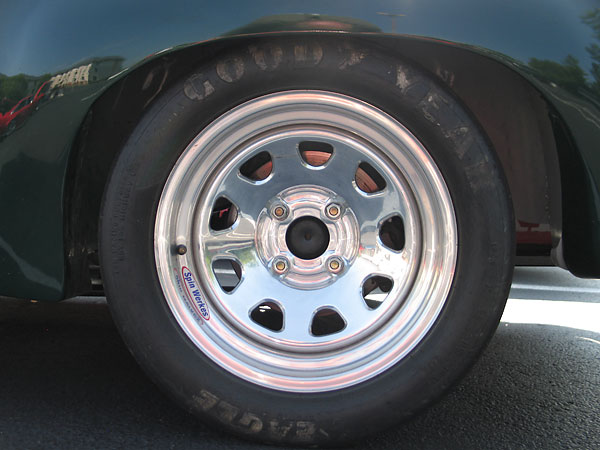
�
Goodyear Eagle 23.0x9.0x15, R430 compound racing slicks.
�
First Race Weekend
��
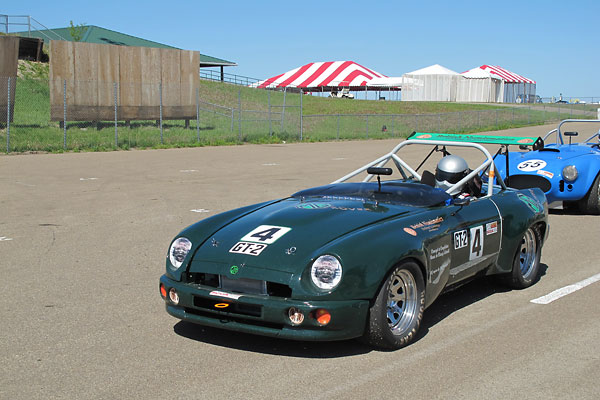
�
Jesse Prather volunteered to drive the RV8 at it's debut SCCA race at Heartland Park, Kansas.
�
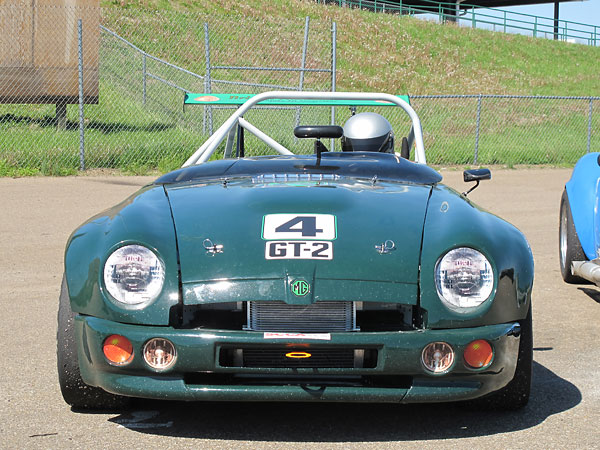
�
Jesse is a three time SCCA national champion who operates a top-flight Miata race-prep shop.
�
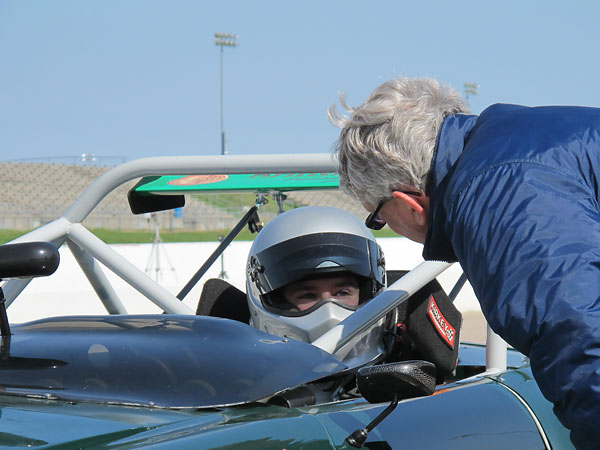
�
Jesse's comments about the car's set-up have been very helpful. One of the first priorities
�
after fixing the MG banjo rear axle, which broke the first-time-out, is changing axles. Then
�
axle and transmission gears will need to be optimized to suit the engine's torque curve.
�
Jesse also suggested stiffer rear springs and shock absorber valve settings.
�
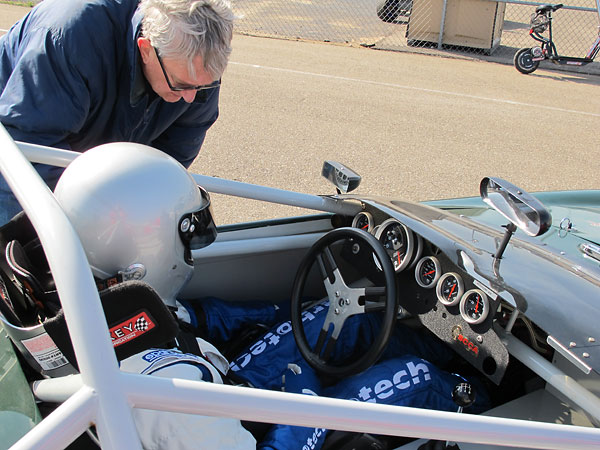
�
Another concern is the crankcase breather. After this first weekend, the team added an
�
additional vent location at the front of the engine. Specifically, they'll now vent air
�
from a port located on the un-used mechanical fuel pump boss (i.e. on the timing cover.)
�
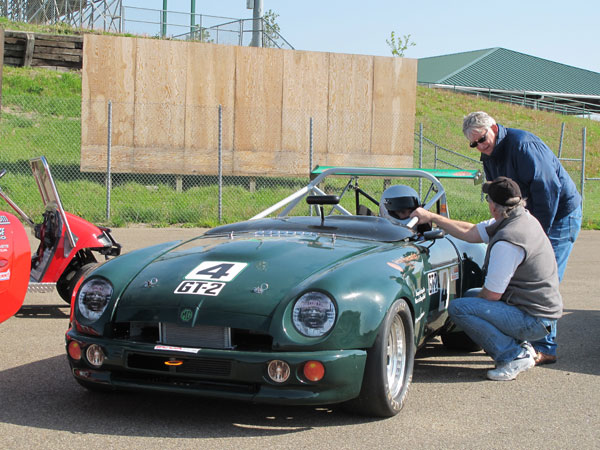
�
There's little doubt that the car will need bigger brakes too, to dissipate the extra
�
heat energy of slowing the car from higher speeds upon entry to every single corner.
�
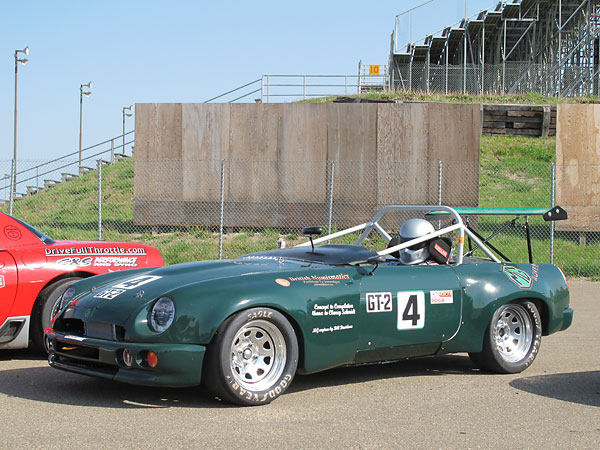
�
Considering the intake restriction it's currently obliged to run, the RV8's first race appearance
�
was judged perfectly respectable. As expected, the car does have a power dissadvantage,
�
but it's not just a "rolling chicane" and it WILL get faster with development. This engine was
�
conservatively built, the next one will be less so. Once the RV8 finishes races reliably, the
�
team intends to petition SCCA to increase the mandated restrictor plate size.
�
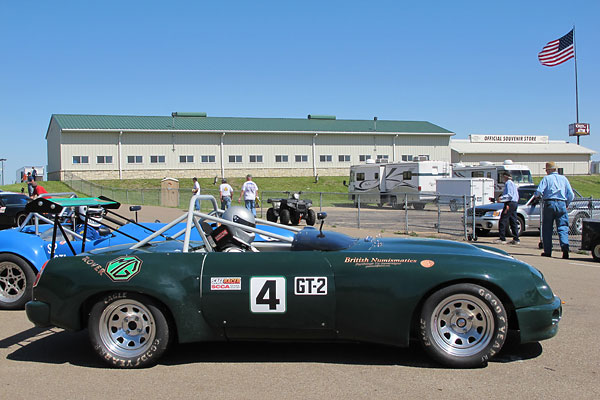
�
To race in SCCA, MGBs must normally choose between two classes. If they comply with more
�
restrictive "Limited Prep" rules, they can run in H-Production. "Full Prep" MGBs run in F-Production.
�
Now there's a third possibility: with RV8 body mods and a Rover V8, MGBs can now run in GT2.
�
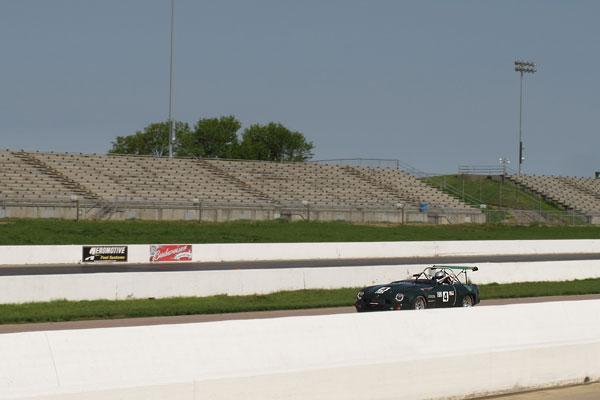
�
SCCA rulemakers have also added MG's MGB GT V8 model to the GT2 class. The question is
�
competitiveness. For MG RV8s and MGB GT V8s to be successful in GT2, SCCA will need
�
to enlarge the induction restrictor plate they require for the Rover V8 engine.
�
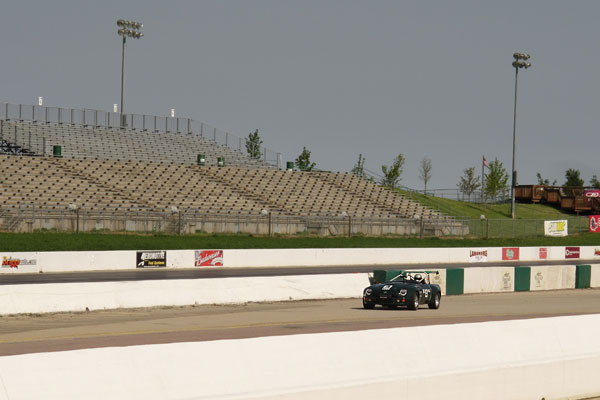
�
The team is under no illusions. The learning curve toward competitiveness in SCCA GT2
�
will be steep and long, but even the longest journeys must start with a single step.
�
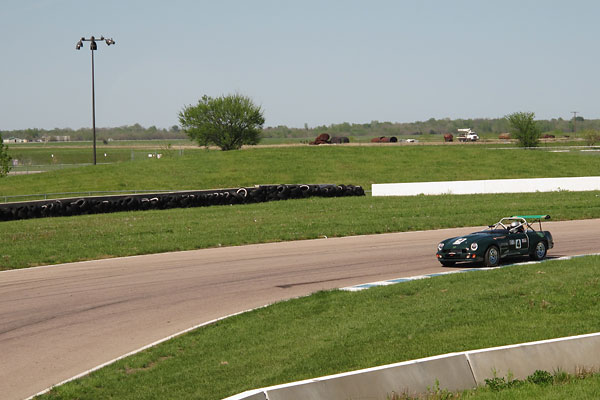
�
The process of building an MG to contest GT2 races has been exciting so far, and it will be
�
even more fun and rewarding as the car and the team continue to develop.
�
| Notes: | |||
| (1) | ��
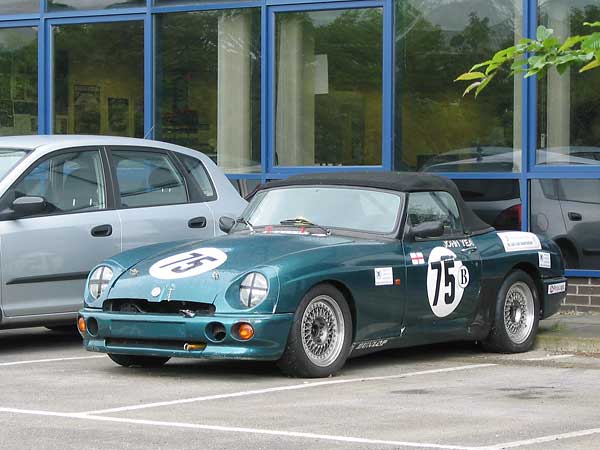 � British Motor Heritage� Managing Director John Yea has campaigned this MG RV8 race car in � England. (Photo by Curtis Jacobson, September 2007.) � | ||
| (2) | �
Note: official SCCA mandated minimum weight for a GT2-spec RV8 at race end is 2,280lbs,�
driver included. However, SCCA's General Competition Rules list two specific relevant allowances:�
(1) minus 50lbs for use of 15X7 wheels, and�
(2) minus 1.25% (i.e. 28.5#) for use of a "frictionless" transmission. � | ||
�
Unless specifically captioned otherwise, all photos shown here are from Indianapolis Indiana�
(taken during BritishV8 2010) or from Heartland Park Raceways in Topeka Kansas.�
Photos by Curtis Jacobson for BritishRaceCar.com, copyright 2011. All rights reserved.
�
| If you liked this article, you'll probably also enjoy these: | �|||||
 | �
Keith Burnett 1972 MGB GT V8 | �
 | �
Storm Field 1972 MGB GT V8 | �
 | �
Les Gonda 1973 MGB GT V8 | �
�
| You're invited to discuss anything you've seen here on The British Racecar Motorsports Forum! | �|||||
�
Notice: all the articles and almost all the photos on BritishRacecar.com are by Curtis Jacobson.
�
(Photos that aren't by Curtis are explicitly credited.) Reproduction without prior written permission is prohibited.
�
Contact us to purchase images or reproduction permission. Higher resolution images are optionally available.
�

 �
�